
savingearth ELECTRIC SCHOOL BUSES ARE CHARGING AHEAD SHARK SUPERPOWERS MICROPLASTICS TINY BUT TERRIBLE PROTECTING OUR OCEANS savingearth4kids.com BE A SAVING EARTH SUPERHERO FALL 2022 / $6.99 CAN






















































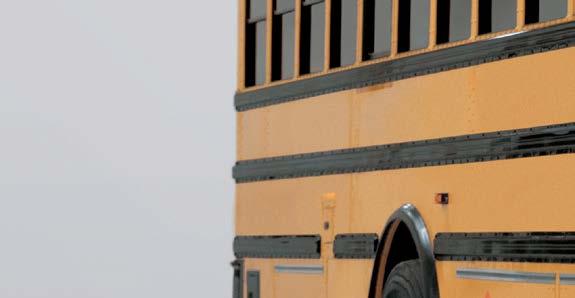



















































































































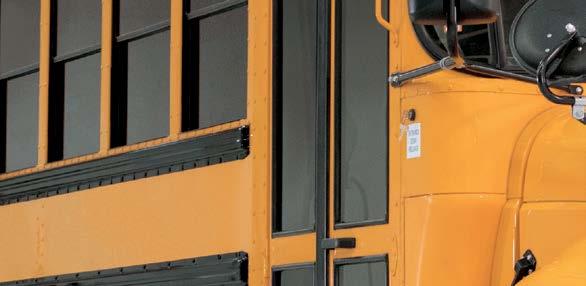

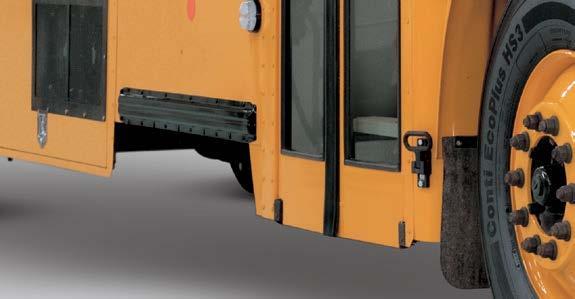

Introducing the all-new Electric CE Series from IC Bus
It is the first electric school bus to really get it right. We’ve worked hard to bring you the most advanced electric school bus in the industry, in the same safe, driver friendly package you’re used to getting from us. Now is the best time to go electric. Find the best way forward at icbus.com/electric








THERE’S NO BETTER TIME TO GO ELECTRIC






























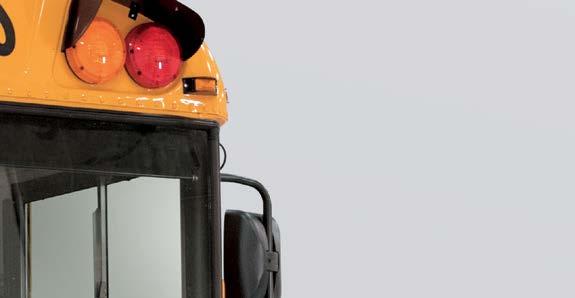
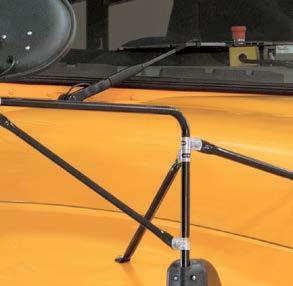





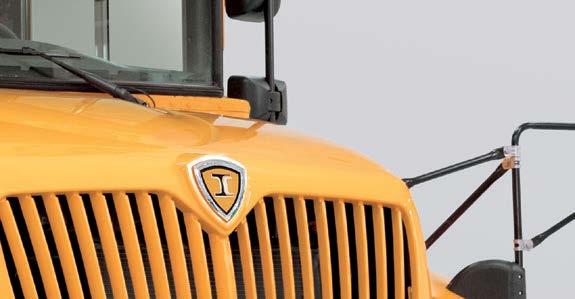




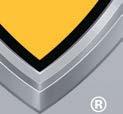











©2022 , Inc. All rights reserved. All marks are trademarks of their respective owners.
SAVING EARTH FOR KIDS | 3 CONTENTS Saving Earth for Kids wants to help you understand environmental issues and find solutions for saving and preserving the Earth. Through stories, games, and activities, we will show you how to be the superheroes our planet needs! HELLO SAVING EARTH SUPERHEROES Article and Word Search ELECTRIFY YOUR RIDE TO SCHOOL In the Nechako Watershed SAVING STURGEON At the Wildlife Rescue Centre CARING FOR CRITTERS Article and Quiz CHARGING AHEAD WITH ELECTRIC SCHOOL BUSES How to Spot Them ORANGUTANS An Invitation into the World of Forest Communities MOTHER TREES WHAT’S HOT INSIDE?
10 12 19 20 22 24 26 Article & Quiz MICROPLASTICS 30 savingearth savingearth savingearth savingearth SHARK SUPERPOWERS Article, Craft, and Kids Can Save Sharks Tips 10 QUESTIONS FOR THOMAS To Tackle Plastic Pollution WHY CANADA MUST DO MORE 36 MUSICAL BREAK 34 A Six-year-old Environmental Hero from Ontario Article & Colouring Page A WALK THROUGH THE FOREST 29 With The Oot n' Oots Family Band from Kelowna, BC. 5 The Wheels on the Bus Go 'Round and 'Round EDITOR'S LETTER
6



a cleaner ride for our kids? ForOurKids.ca #eBus Join
Want
the campaign to bring electric buses to schools across Canada.

FALL 2022
PUBLISHED BY SAVING EARTH
EDITOR-IN-CHIEF
Teena Clipston
ASSOCIATE EDITOR
Jessica Kirby
GRAPHIC DESIGN
Cassandra Redding & Teena Clipston
CONTRIBUTORS
Ruth Kamnitzer from ForOurKids, Brandon Szabo from IC Bus, Jillian Morris from Sharks4Kids, The Oot n' Oots faimly band, Jordon Cranmer from Nechako White Sturgeon Recovery Initiative, Author Nicholas Read, Ruth Linsky from Orangutan Foundation International Canada, Ascher & Cher from Sierra Club BC, Author Angela Legh, Saving Earth Green Team, Mind Your Plastic, and Sarah King from Greenpeace.
COVER PHOTO
iStock/FatCanada
SPONSORED BY NAVISTAR, IC BUS
ADDITIONAL CREDITS
Vecteezy.com
Saving Earth for Kids Magazine has made every effort to make sure that its content is accurate on the date of publication. The opinions expressed in the articles are those of the author(s) and do not necessarily reflect the opinions of the publisher or editor. Information contained in the magazine has been obtained by the authors from sources believed to be reliable. You may email us at Saving Earth for Kids Magazine for source information. Saving Earth for Kids Magazine, its publisher, editor, and its authors are not responsible for any errors, omissions, or claims for damages, and accept no liability for any loss or damage of any kind. The published material, advertising, advertorials, editorials, and all other content is published in good faith.
©Copyright 2022 Saving Earth for Kids. All rights reserved. Saving Earth Magazine is fully protected by copyright law and nothing herein can be reproduced wholly or in part without written consent.
PRINTED IN CANADA
savingearth4kids.com
info@savingearth4kids.com
Phone: 250-754-1599
ISSN 2563-9552 (Print)
ISSN 2563-9560 (Online)
Library and Archives Canada, Government of Canada
THE WHEELS ON THE BUS GO 'ROUND AND 'ROUND W
elcome kids, teachers, and parents to our Fall edition of Saving Earth for Kids!
In this edition, we take a look at the benefits of electric school buses with ForOurKids.ca and IC Bus. Electric buses not only lower greenhouse gas emissions, but also, they help reduce students' exposure to diesel exhaust, a known carcinogen that can cause health issues and make others, like asthma, worse. We look forward to a future with cleaner air and healthier bodies as new technologies and scientific advancements bring us closer to a greener world.
Taking a school bus to school can create some of the fondest memories students have about going to school. On the bus, we get to say good morning to our good friends, share a laugh, catch up on how we are all doing, and maybe even sing a song. Do you know the fun American folk school bus song written by Verna Hills in 1937? Every time I think of a school bus that tune pops into my head! If you don't know it, this is your chance to look it up! Here is an excerpt:

Then, on to orangutans. This is not an animal we see in Canada's wilderness, but the Orangutan Foundation International Canada out of Vancouver, BC, helps protect orangutans in places like Malaysia and Indonesia. Have a read and learn why orangutans are important to forests around the world.
"The wheels on the bus go ‘round and ‘round ‘Round and ‘round ‘Round and ‘round The wheels on the bus go ‘round and ‘round All through the town!"
For animal lovers, this edition includes SHARKS, which perhaps are not as fuzzy and cuddly as our pets at home, but they are an important part of our oceans’ health. Sharks help maintain a healthy ocean ecosystem. Did you know that there are many different types of sharks, and some even have superpowers?
We also head to Vanderhoof, BC, to the Nechako White Sturgeon Conservation Centre to learn all about how to save the Nechako White Sturgeon.
For those who prefer the fuzzy type of animal, the Critter Care Wildlife Society in Langely, BC, may just be the place for you. In his article, “Caring for Critters,” author Nicholas Read shows us how they are helping baby bear cubs and more.
If you love forests and trees, Sierra Club BC teaches us about the Mother Tree and the interconnectedness of the forest and all its inhabitants. Check out their links for even more educational material. Then turn the page and read “A Walk in the Forest” by author Angela Leah. What a great opportunity for us all to discuss the forest and trees in our own province!
We end this edition with the topic of plastic pollution, covering the dangers of microplastics and why Canada must do more to fight alongside Greenpeace against plastic pollution. We also have a look at a local hero from Ontario and what he has done for ocean conservation. What can you do to make a difference?
We would like to thank IC Bus for sponsoring this edition. If you are interested in learning more about electric buses or wish to arrange a school field day to learn more, contact us at info@savingearth4kids.com. We will get you in touch with IC Bus!
- Teena Clipston, Saving Earth for Kids
SAVING EARTH FOR KIDS | 5
CHARGING AHEAD WITH ELECTRIC SCHOOL BUSES
By Ruth Kamnitzer
Ruth is running an electric school bus campaign for ForOurKids. She explains why they are a good idea for kids and the climate.
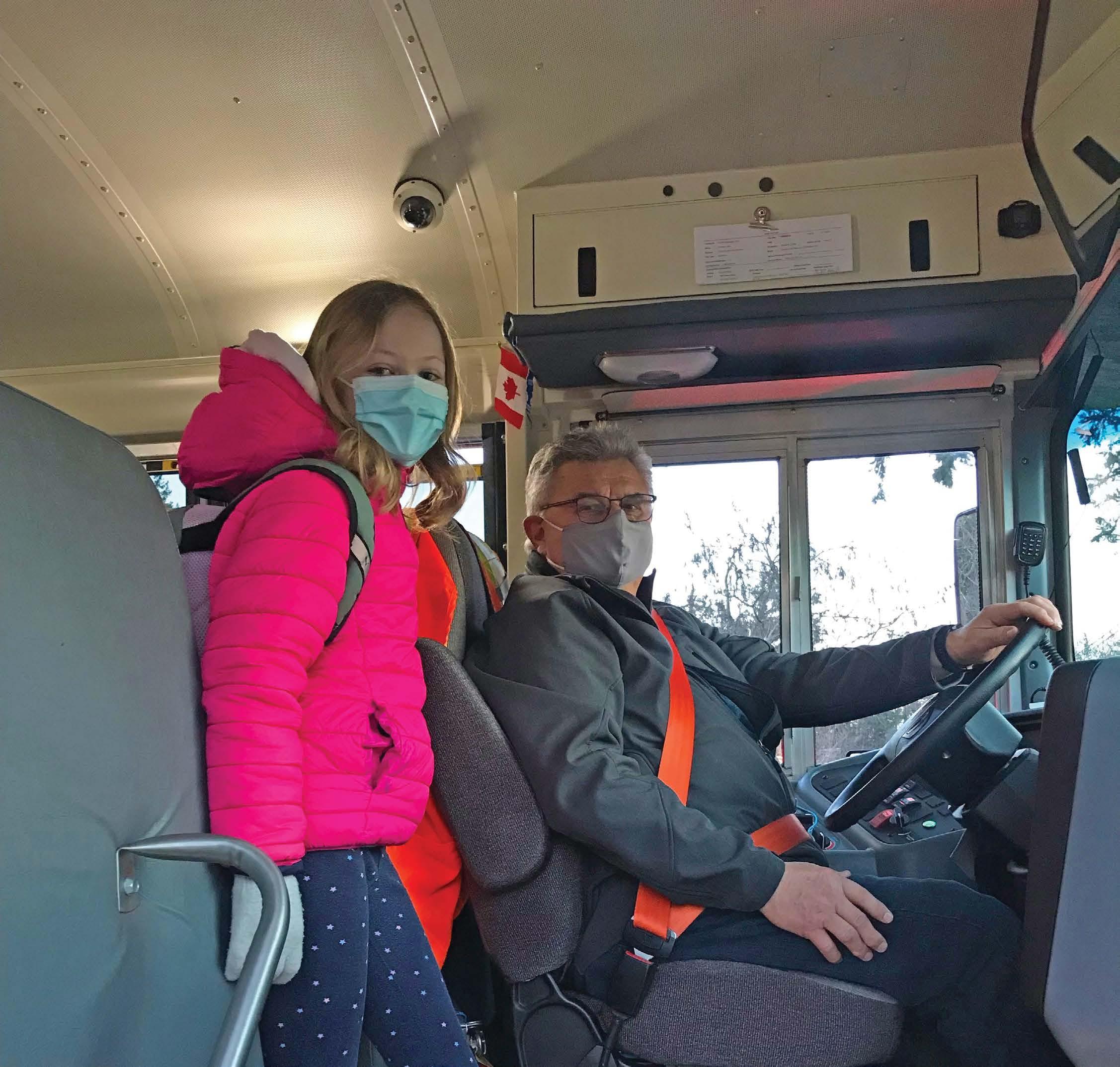
6 | SAVING EARTH FOR KIDS
"Happy kids, happy drivers. Hannah and Al are excited about their new electric school bus."
Photo credit: Mike Davies.
Hannah Davies is in grade 3 at Hans Helgesen Elementary in British Columbia. She’s been riding the school bus since grade 1.
Every weekday, Hannah eats her breakfast (cereal), grabs her lunch (hopefully cheese, mayo, and mustard sandwiches with cucumber on the side), maybe a raincoat (Vancouver Island is a rainy place), and starts walking to her bus stop and if she hears that grinding vroom vroom vroom of the bus coming down the road, she knows she needs to run.
But one day, something unexpected happened. Something a little bit strange and almost magical. Hannah was standing at the bus stop, waiting, when a shiny new school bus rolled up without almost any sound at all.
“The bus was just very, very quiet,” Hannah said.
Right now, most school buses in Canada are powered by diesel fuel. But in May 2021, Hannah’s school district bought an electric school bus. Electric buses don’t give off exhaust or fumes, and they are extraordinarily quiet.
“It’s cool,” Hannah said, “because it’s helping the environment, it’s better for the air, and it’s more peaceful.”
Diesel engines what’s the deal?
Both diesel and electric buses have wheels, but the way they make those wheels go ‘round is totally different.
In a diesel bus, when the driver turns the key and steps on the accelerator, four things happen inside the engine. First, air is sucked into a metal cylinder. Second, a metal rod inside the cylinder (called a piston) squeezes the air so that it gets very hot (over 500 degrees C). Third, tiny droplets of diesel fuel are sprayed into the cylinder and because the air is so hot kaboom! The droplets of diesel begin to combust. That makes the air inside the cylinder expand, which sends the piston to the bottom of the cylinder and transfers power to something called the crankshaft. That power makes the wheels go ‘round. Finally, the used-up diesel/air mixture goes out the exhaust pipe. Then the whole process happens all over again, thousands of times per minute.
Sounds cool—so what’s the problem?
Now, that system works pretty well for moving a seven-tonne school bus carrying 70 rowdy kids, but there are two problems with diesel engines.
Diesel is made from oil, one of the fossil fuels. When that diesel fuel burns inside the engine, carbon dioxide (CO2) is released and goes out the tailpipe, into the air, and up to our atmosphere. As you might already know, CO2 is a greenhouse gas; it traps heat and causes climate change. That’s not good.
The other problem with diesel buses is that the fumes coming out of the exhaust pipe aren’t good for our health. If you’ve ever stood next to an idling diesel school bus, you probably already know that breathing in the exhaust doesn’t make you feel very good it stinks and it might make your eyes water or give you a headache. For kids who have asthma, other respiratory conditions, or allergies, exposure to diesel exhaust can make things even worse.
What’s different about electric school buses?
Instead of a fuel tank, electric school buses have batteries and a socket. Instead of filling up at the gas station, you plug them in to charge up the battery, just like a phone. And instead of an engine, they have an electric motor.
In an electric bus, when the driver switches it on and steps on the accelerator, the battery sends electricity to the motor, which turns the gears that make the wheels go ‘round. That’s it no mini explosions or diesel exhaust or smelly fumes coming out the tailpipe. In fact, there’s no tailpipe at all!
Why are electric school buses better for the planet and our health?
Electric school buses are zero emission vehicles, meaning they don’t produce greenhouse gases when they are running. Each electric school bus saves approximately 17–23 tonnes of greenhouse gases per year, compared to a diesel bus. That’s about the weight of 15 moose!
The good news is, you could be riding an electric school bus soon.
Many school districts all over North America are starting to go electric. Though electric school buses cost more to build, they are cheaper in the long run because you don’t need to pay for diesel, plus they cost less to maintain.
KNOW? KNOW? YOU YOU DID DID
In the 1800s, kids rode to school in converted farm wagons called ‘kid hacks’ watch out for stray turnips, kids!
The first purpose built ‘school car’ was made in 1892. It had benches along the sides, a roof (but no windows), and was pulled by horses. The doors were at the back so rowdy kids didn’t startle the horses.
Starting about 1915, engines replaced horses, and school buses started to look a little more like the ones we have today.
In 2015, Lion Electric produced Canada’s first full sized electric school bus.
In North America, school buses are bright yellow. That’s a safety feature the bright yellow colour is easy to see. But in Japan, school buses are sometimes painted like cats and other animals!
Better for the environment, better for our health, and cheaper in the long run it’s a no brainer.
Convinced? Talk to your school administration and tell them you’d like to ride an electric bus too. Then keep your eyes and ears open you never know when something magical might appear at a school bus stop near you!
SCHOOL BUS SAVING EARTH FOR KIDS | 7
School Bus Electrification Facts
*note: these are primarily 2018 figures, taken from School Bus Fleet Canadian Fact Book 2018, with some additional personal communication.
• Number of school buses in Canada: approximately 46,500 (excluding the Yukon, NWT, and Nunavut)
• Number of kids riding the school bus: approximately 2.1 million (excluding the Yukon, NWT, and Nunavut)
• Number of passenger kilometers covered: 32, 757 million)
• Amount of CO2 equivalent emitted: 0.6 mt
WHAT DRIVERS HAVE TO SAY GREENER WAYS OF GETTING TO SCHOOL
Al Kolwalko has been driving a school bus for nine years. Last year, he started driving an electric. Here’s his take.
Q: What was the first thing you noticed about the electric bus?
A: It’s very quiet.
Q: And the driving?
A: It’s got lots of power. Great acceleration. You turn it on and it’s like turning up the dial on a light that has a dimmer.
Q: In a race, 0–50 kms/hr, diesel vs electric? Who do you think would win?
A: I’d say the electric (Don’t worry, folks, Al hasn’t tried this!)
Walking, riding your bike, or using a scooter are the most environmentally friendly ways to get to school. You’ll get exercise and fresh air, plus there are no carbon emissions. Designated walking and cycling routes can help make the journey safer. Some schools operate ‘walking buses’, where kids in the neighbourhood walk together under adult supervision.
But for kids who live too far away to walk or bike, taking the school bus is the next best option. Taking the school bus means there are fewer private vehicles on the road, and that means less pollution. Of course, electric school buses are an even better option!
8 | SAVING EARTH FOR KIDS
TEST YOUR KNOWLEDGE
1. At night, plug your electric school bus in with a charging __________.
2. Electric school buses are also called zero __________ vehicles.
3. In a diesel bus, __________ comes out the tailpipe.
4. To make the bus slow down or stop, the driver steps on the __________.
5.
__________ buses don’t produce greenhouse gasses while they are running.
6. One of the greenhouse gasses is called __________ __________.
7. Instead of a fuel tank, an electric bus has a __________.
For Our Kids is a national network of parent-led, community-based grassroots groups involved in climate action. We strive to be a welcoming place for parents, guardians, and grandparents to connect and take climate justice action together. Our work begins with recognizing and respecting Indigenous Rights.
Together we strive for climate justice—curbing emissions and addressing racial, economic, gender, and other inequities. Inequitable systems intensify climate change impacts on already marginalized communities. Our vision is a just and sustainable world where our kids can grow up healthy and happy. Will you join us?
carbon dioxide, 7. battery.
Answers: 1. cable, 2. emissions, 3. exhaust, 4. brakes, 5.
6.
Learn more at
Electric,
www.forourkids.ca
SAVING EARTH FOR KIDS | 9
FOR PARENTS & TEACHERS
ELECTRIFY YOUR RIDE TO SCHOOL YOUR TO SCHOOL YOUR RIDE TO SCHOOL ELECTRIFY ELECTRIFY
By Brandon Szabo, Contributor from IC Bus
It’s time for school! The new school year can bring many surprises and learning experiences. It also means it is time to get back into the school routine. For many students, an important part of this routine is getting up in the morning and waiting at the bus stop for their school bus to arrive.
Quiet Ride to School
The wait for the school bus on the first day can be exciting as you want to tell all your friends about the fun things you did over the summer. With all the excitement you may not even notice the bus has just arrived! The new electric school buses are quieter than ever. You can now enjoy a quiet, smooth bus ride on your way to school while talking with friends and catching up on what you did over the summer.
Saving the Earth

When the school bus arrives, you will not only notice that it is not making any sound, but there is no smell or smoke either. Going electric helps keep the earth safe by reducing the amount of carbon emissions which are toxic fumes that pollute the air. That means the electric school bus is good for the planet and good for your own health too! You will not want to hold your breath when you get on the bus because electric school buses do not have toxic fumes that
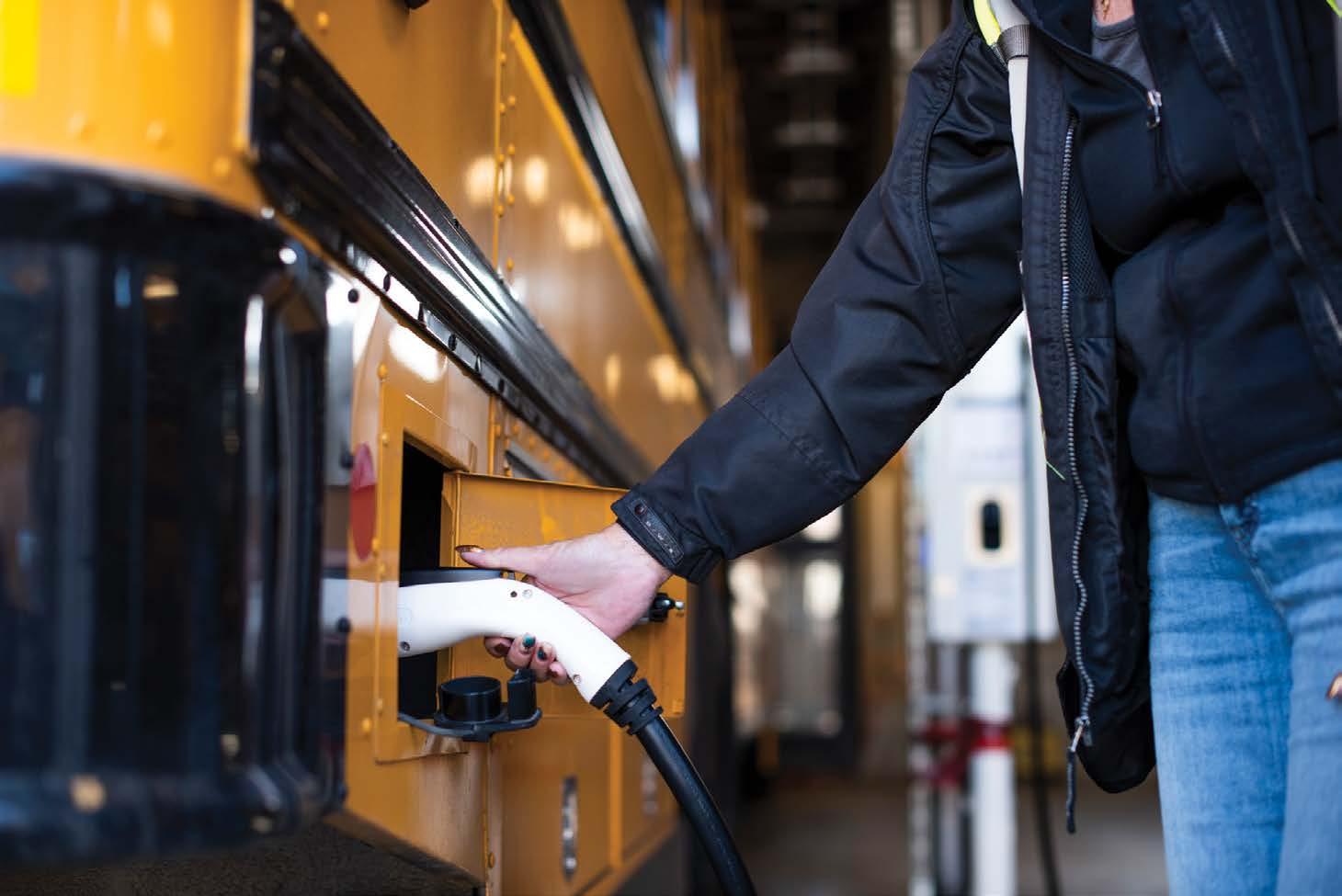
Electric school buses are the future of transportation and provide a better future for people and the planet. You can help reduce the amount of carbon emissions with every ride on an electric school bus.

Time to Recharge
Electric school buses run on big batteries, and it is important to charge the school bus's battery overnight just as it is important to get a good night’s rest for school. The short rides to and from school give electric school buses the perfect chance to rest and recharge between routes
ELECTRIC SCHOOL BATTERIES BUSES RUN ON BIG
10 | SAVING EARTH FOR KIDS
Word search
From IC Bus

SAVING EARTH FOR KIDS | 11
By Jillian Morris, sharks4kids.com
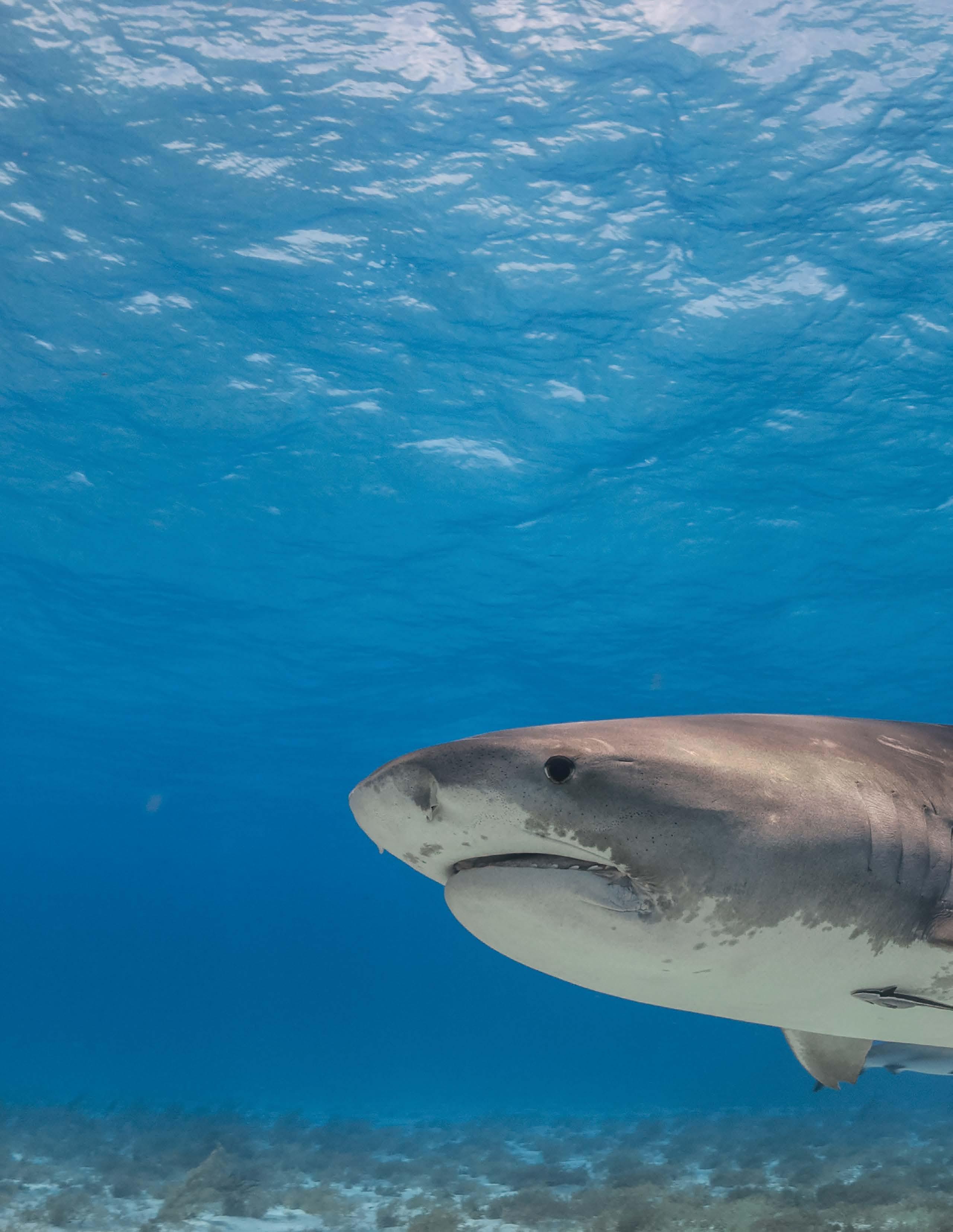
SHARK SUPERPOWERS
There are over 500 different species of shark and they’ve been around, in some form, for over 400 million years (yes, even before dinosaurs!). If you look at photos of just a few sharks, you will notice they have different shapes, sizes, colours, and patterns. Sharks also have some very cool adaptations (superpowers) that help them survive in different habitats. Some species leap out of the water (Great White sharks), some can walk (Epaulette sharks), and others have remarkable camouflage (Wobbegong sharks). Turn the page for more impressive shark superpowers!
Tiger shark. Photo credit: Jillian Morris.
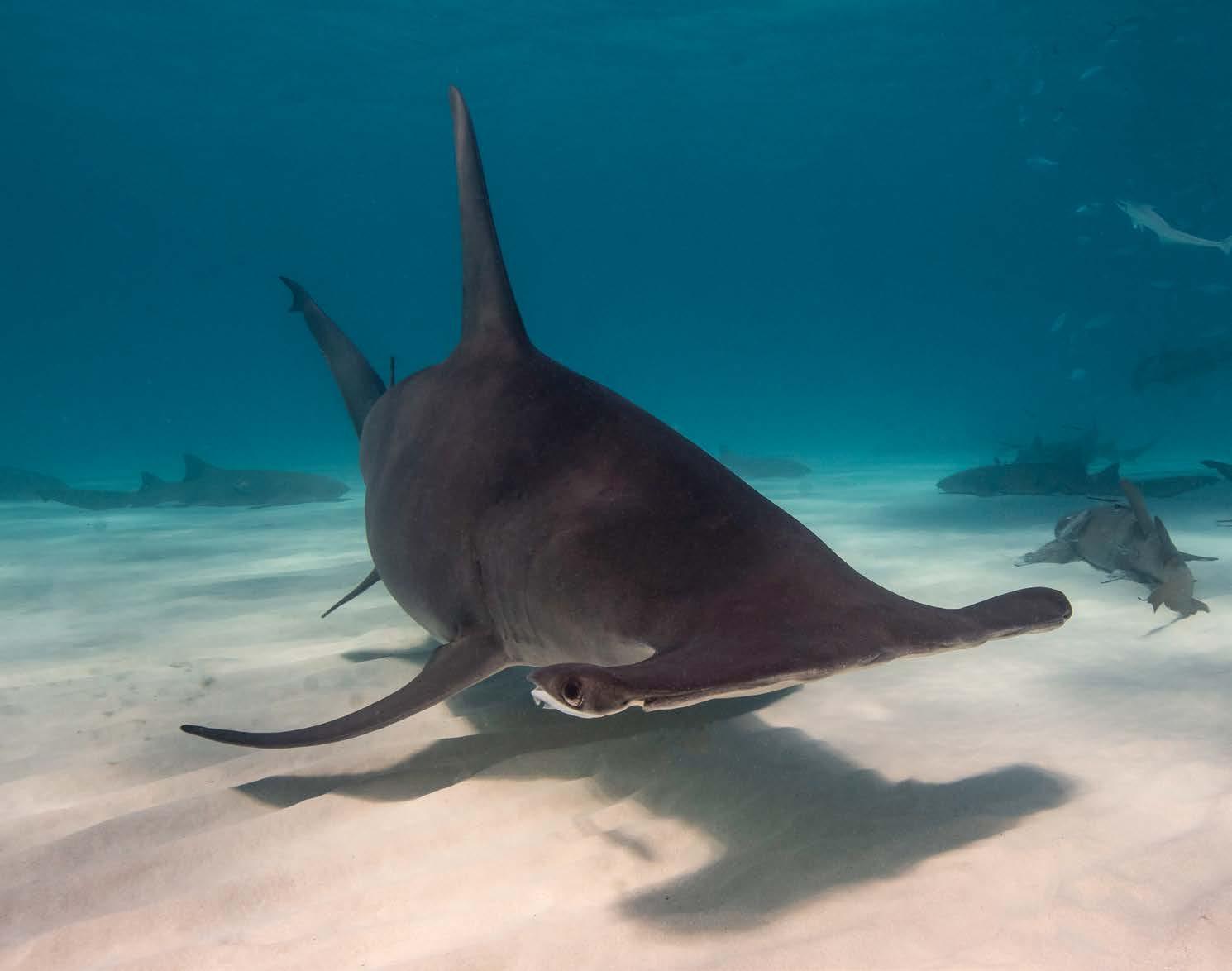


Turn the page for more shark facts!
Lemon sharks. Photo credit: Jillian Morris.
Hammerhead shark.
Photo credit: Jillian Morris.

Superpower #1: Speed—
Shortfin Mako Shark (Isurus oxyrinchus)
Imagine if you had to chase your sandwich and then try to grab it with just your mouth. Luckily, our food just sits there, and we do not have to be quick to grab it. When you are a shark, though, your lunch doesn’t want to be on the menu, so it will usually fight or swim away. Shortfin mako sharks eat some very fast fish, including tuna, swordfish, and even other sharks, so they cannot be slow! They are the fastest known species of shark and have been recorded at speeds of 30–46 mph! These “cheetahs of the ocean” keep their muscles warmed up and ready for bursts of speed through a process called thermoregulation. Sharks are cold-blooded animals, meaning their body temperature is the same as the water around them. Makos, as well as Great white sharks and Salmon sharks, can actively regulate their internal body temperature, keeping it warmer than the water they are swimming in. With muscles warmed up and ready to sprint, they are ready to catch their fast food!
Superpower #2: Swimming in Freshwater—Bull

Shark (Carcharhinus leucas)
When you think of sharks, you probably think of the ocean. Did you know there are actually freshwater sharks? The five known species of river sharks are some of the rarest and most endangered sharks in the world. While we do not know a lot about river sharks, scientists have been able to study Bull sharks for many years. This species can actually swim in both saltwater and freshwater, and they have been found over 1,000 miles up the Mississippi River. They can quickly adapt to the lack of salt using osmoregulation. This is the process where the body can adjust to the changing level of fluids and dissolved materials in them (like different amounts of salt). When they are in freshwater, their kidneys produce large amounts of urine to help remove excess water. Bull sharks pee 20 times more often when they are in freshwater than they do in the ocean!
14 | SAVING EARTH FOR KIDS
Shortfin Mako Shark. Photo credit: Ron Watkins.
Bull sharks. Photo credit: Jillian Morris.
Superpower #3: Glowing—Swell Shark
(Cephaloscyllium ventriosum)
Do you think sharks can glow? Sounds weird, right? Weird and wonderful and yes, some sharks can glow (produce light). Swell sharks use a protein in their skin that glows green when activated by blue light. Scientists only recently discovered this and were able to see using special cameras. It is believed this ability to “glow” might be used to communicate with other Swell sharks, who have eyes adapted to see this green light. This is called biofluorescence, which is when an animal absorbs one colour of light and reemits (releases) another.
Lantern sharks produce light in a different way called bioluminescence. These deepsea sharks have special light producing organs in their skin called photophores. It’s believed they use their ability to produce light to camouflage or to attract prey. Superpower
#4: Vision and Electroreception— Great
Hammerhead
Shark ( Sphyrna mokarran)
Last, but certainly not least, is the great Hammerhead shark. Let’s start with their head, which is known as the cephalofoil. Not only does their oddly shaped head make them unique; it’s also the control center for some of their amazing adaptations. The shape allows their eyes to be set further apart, which actually gives them exceptional vision. Their S shape swimming pattern, along with their wide set eyes, allows this shark to see from side to side, but also above, below, in front, and behind.
All sharks
have a sixth sense known as electroreception. They have tiny gel-filled pores called the Ampullae of Lorenzini, which can detect electrical pulses. As a shark swims over the bottom, they might not see, hear, or smell a fish buried in the sand, but these pores can feel the heartbeat! Think of it like a metal detector, but instead of lost jewelry or treasure, the shark is looking for lunch! By having wider heads, these sensory organs can be more spread out. This makes this adaptation truly super-powered! Sharks definitely have some incredible adaptations that help them survive. If you were a shark, what would your superpower be?
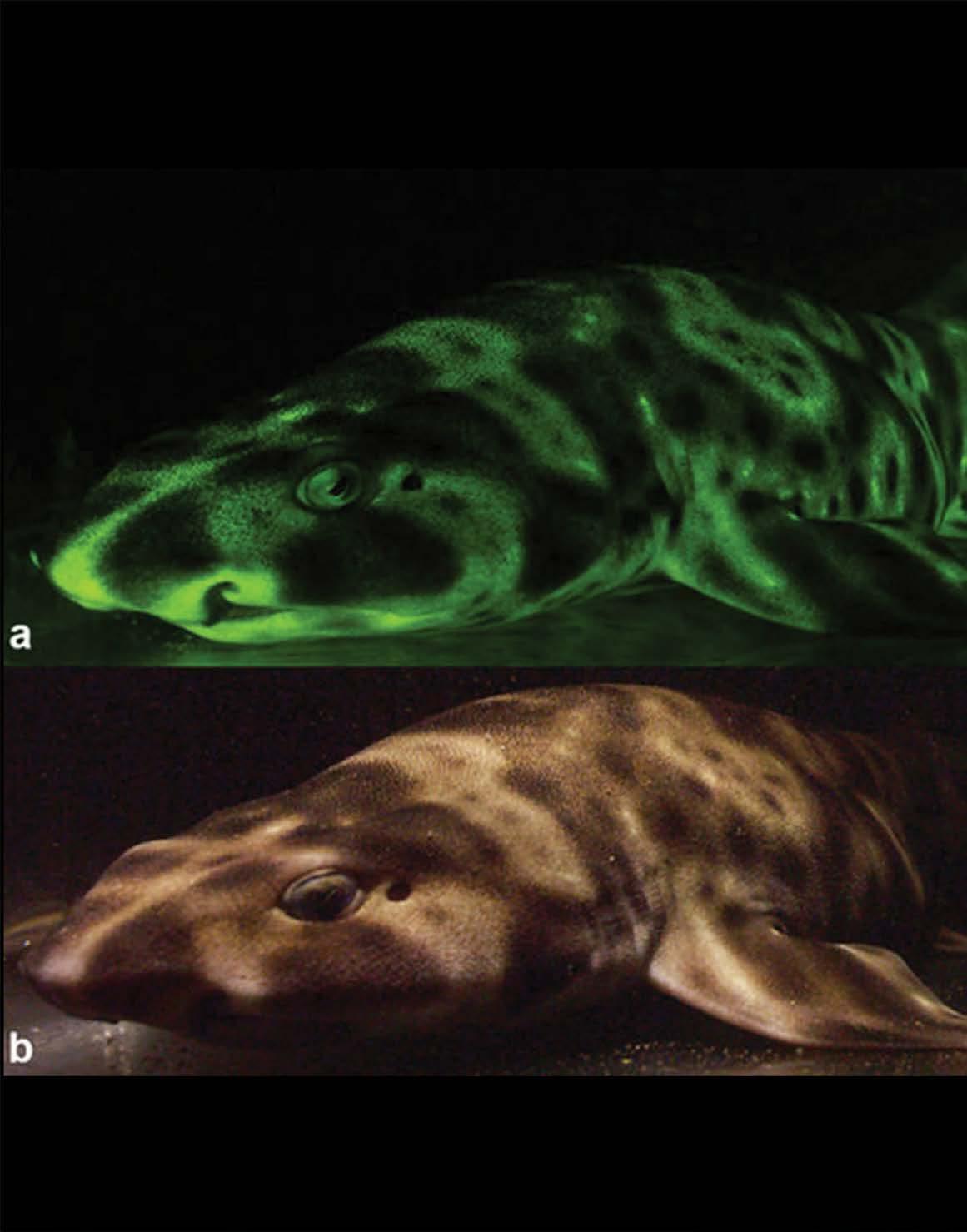
Glowing-Swell Shark. Photo credit: David Gruber.

Hammerhead sharks. Photo credit: Jilian Morris.
SAVING EARTH FOR KIDS | 15
CRAFT TIME
Toilet Paper Roll
Hammerhead
Materials:
• Toilet paper roll
• Card stock paper
• Scissors
• Paint - grey and white
• Black permanent marker
1. Draw out on a piece of card stock, one large dorsal fin, two pectoral fins, one large caudal fin (tail), and a cephalofoil (the hammer shape). You can use the end of the roll as a guide to how wide the tail fin and head need to be.

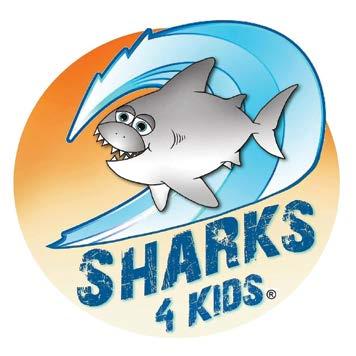
2. In the toilet paper roll, cut two slits horizontally for the head, two slits vertically for the tail fin, a slit on either side for the pectoral fins, and one on the top for the dorsal fin. *Take care with the scissors when making the top and middle slits.
3. Paint the toilet roll, fins, and head. Grey and white paint creates the countershading used for camouflage.
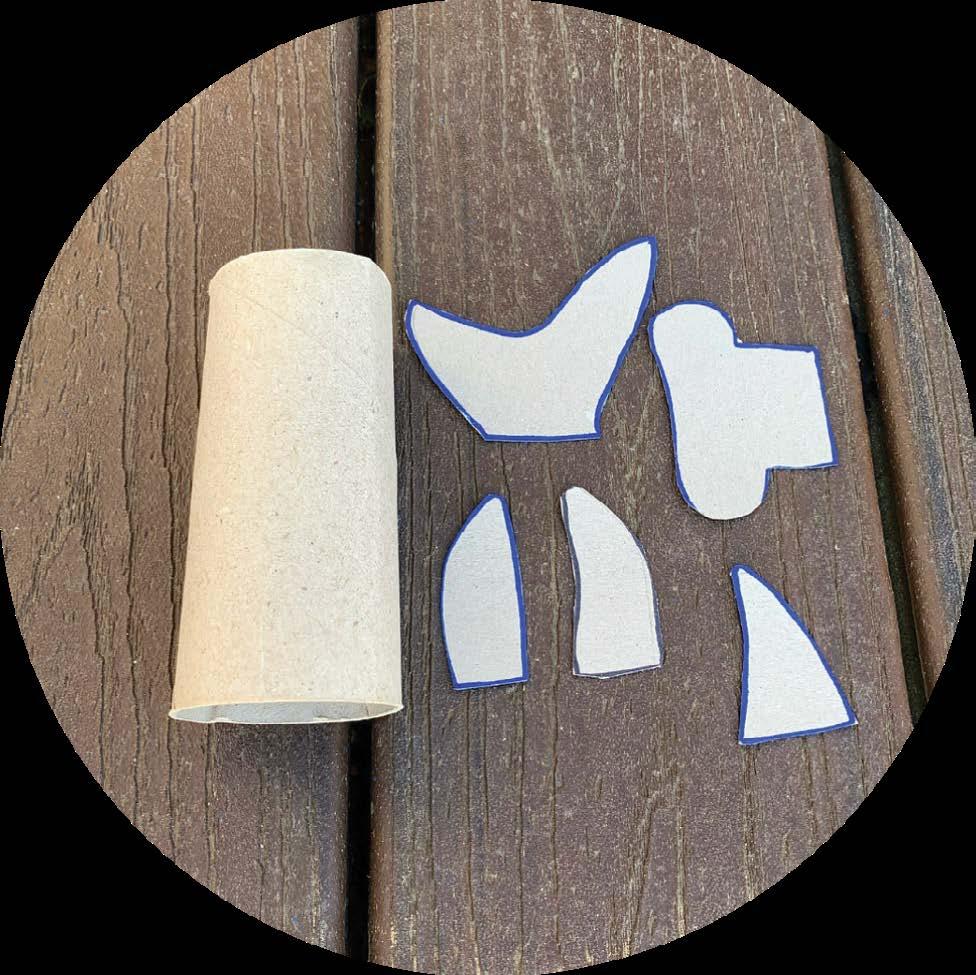
4. When the paint is dry, slot in all the pieces and use the permanent marker to give your little friend five gill slits, eyes, and a mouth.
5. Why not add some Ampullae of Lorenzini (electroreceptors) to your new buddy? It can use them to hunt down those sneaky sting ray. You could create a whole underwater scene!
16 | SAVING EARTH FOR KIDS
www.sharks4kids.com
By Jillian Morris
KIDS CAN SAVE SHARKS
Kids learning how to snorkel. Photo credit: Jillian Morris.
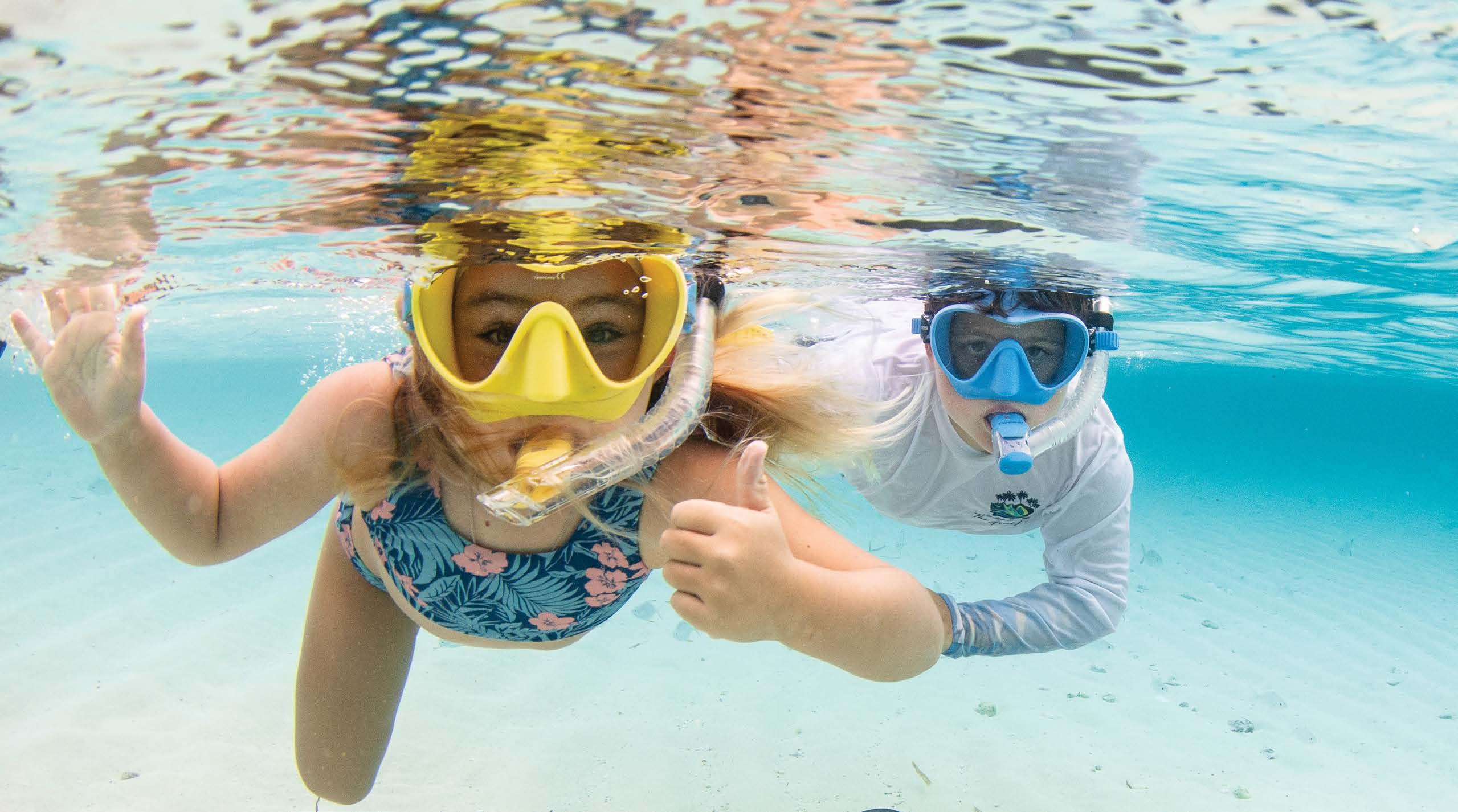
Sharks are amazing animals, but did you know they are also really important? They help maintain the balance of ecosystems, which keeps the oceans healthy. They are not always apex predators (top of the food chain), but they do always eat other animals. This helps keep the population of the animals that are lower on the food chain from getting too big. You can think of sharks as ‘managers’ of the reef, making sure everyone is doing their job.
No matter where we live, we are connected to the ocean every single day, and we need healthy oceans. Some of the food we eat, water we use, products we buy, and even some of the oxygen we breathe comes from the ocean!
A lot of people are afraid of sharks because they think they are people-eating monsters, but in reality, they are in trouble and they need our help! Humans kill approximately 100 million sharks every single year. More than one third of all sharks, rays, and chimaera (ghost sharks) are threatened with extinction.
Although sharks are fish, they do not lay thousands of eggs. Some sharks might only produce one egg case, while others actually give birth to live young. Sharks grow slowly, take years to reproduce, and do not have lots of young. These traits make them vulnerable to overfishing (taking too many fish out of the sea).
Here a few fun and easy ways you can help save sharks!
1. Be a Junior Shark Scientist
Scientists ask questions, collect data, and then share their findings. These are all things you can do. There is a lot of misinformation out there about sharks, so learning facts is an important step. Find books at your library, watch a documentary, or do some research online. Pick one species and learn five facts about them. Create a poster, make a video, or even write a song to share with your friends, classmates, or family. Sharks4Kids.com has lots of fun activities, crafts, facts, posters, and videos you can learn from.
2. Beach Cleanup
Picking up trash is good for all of us and for the whole planet, but it definitely helps the oceans. Animals, including sharks, get tangled in marine debris, which can cause
serious or even fatal injuries. Animals also eat trash and debris, which can make them sick. If we remove trash from the beach, we can prevent it from going into the water. Even if you are not near the ocean, you can still make a difference. Trash on the ground anywhere can end up in a river or stream and eventually find its way to the ocean. Have a look in your school yard, your neighborhood, or a park you might visit, and I’ll bet you will see trash on the ground. Each piece you pick up can make an impact and might just inspire your friends and family to do the same!
3.
Avoid Shark Products
Did you know shark can be found in vitamins, dog treats, and makeup? It’s a good idea to read the label on products and see what they are made of. You can ask your parents or another adult to help with this. It might not say “shark” on the label, so you have to be a good detective and look for other words like “squalene”. This is a compound found in shark liver, which is used in different makeup products, lotions, and vitamins.
Have you ever seen a shark tooth necklace? Was the tooth white? This means the tooth is newer. It’s best to avoid these products, as well. Instead, you can look for fossilized shark teeth!
4.
Learn to Snorkel or Scuba Dive
If you are old enough, snorkelling and scuba diving are amazing ways to be an ocean explorer. You can learn a lot about different animals and habitats by observing them! It is easier for us to care about something when we have seen or experienced it. Don’t worry if you do not live near the ocean; there are also some great aquariums where you can see all sorts of remarkable marine life. You can even scuba dive at some of these. This is another tool you can use to learn about the oceans and then you can share your JAWsome adventure with other people!
5.
Use Less Plastic
You might not think plastic impacts the ocean, but it does. Sharks and other marine life get tangled in plastic and sometimes they eat it. We can skip the single use plastics and choose reusable water bottles, cups, silverware, straws, and grocery bags. You can ask the adults in your life to switch to a reusable coffee cup. You can even find all of these items with sharks printed on them!
SAVING EARTH FOR KIDS | 17

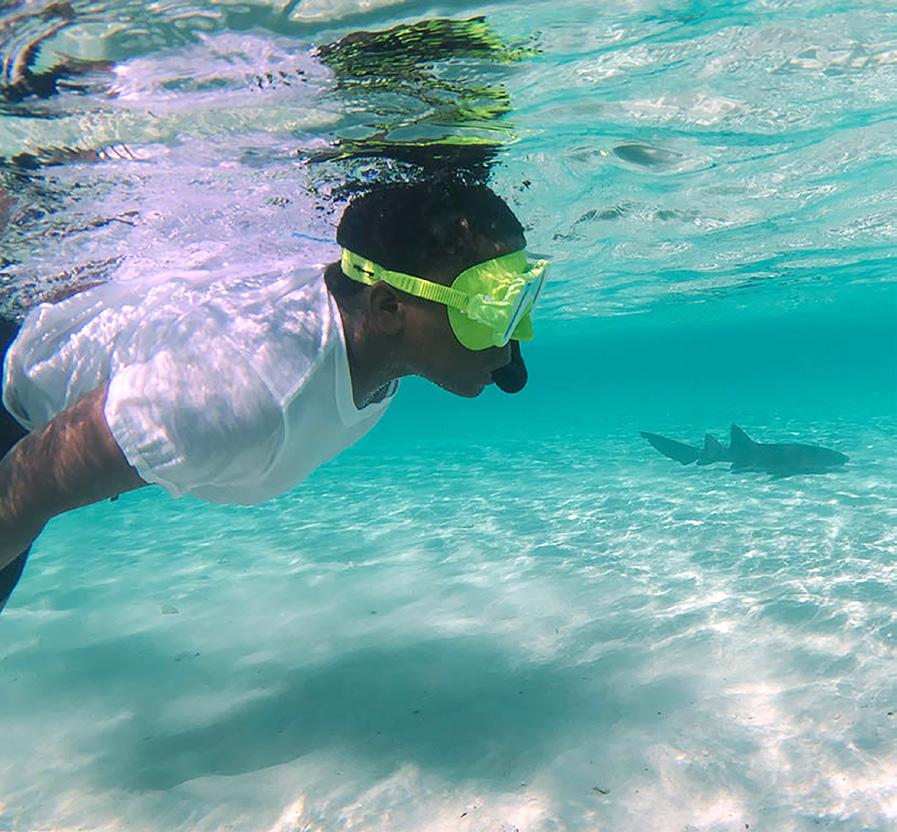
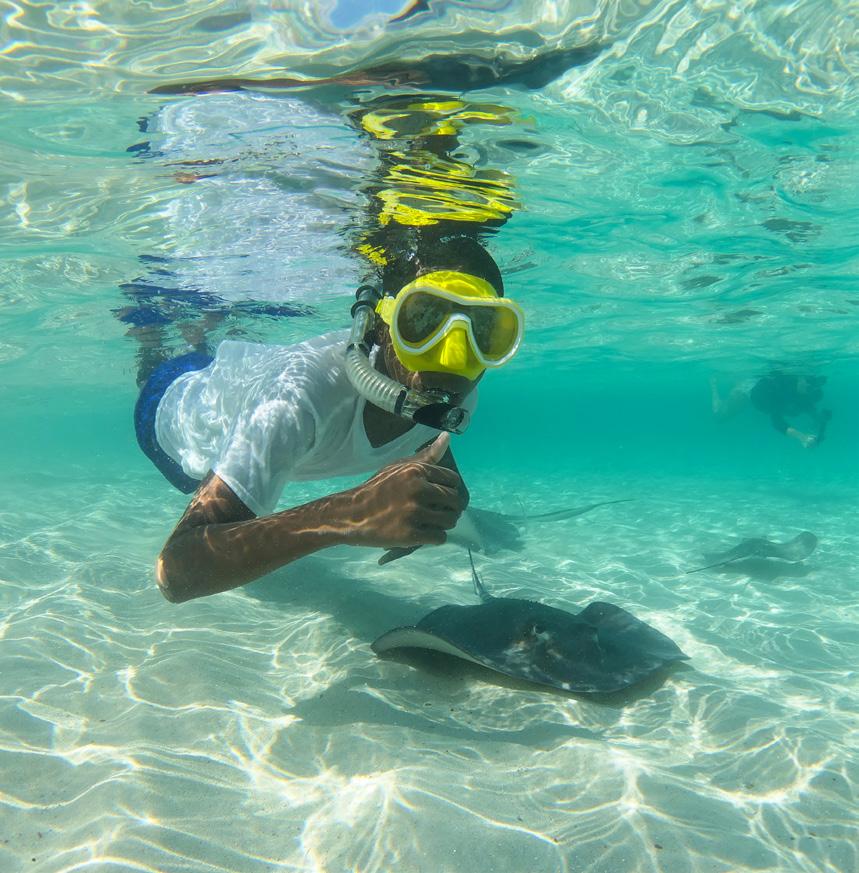
CREATING THE NEXT GENERATION OF SHARK ADVOCATES


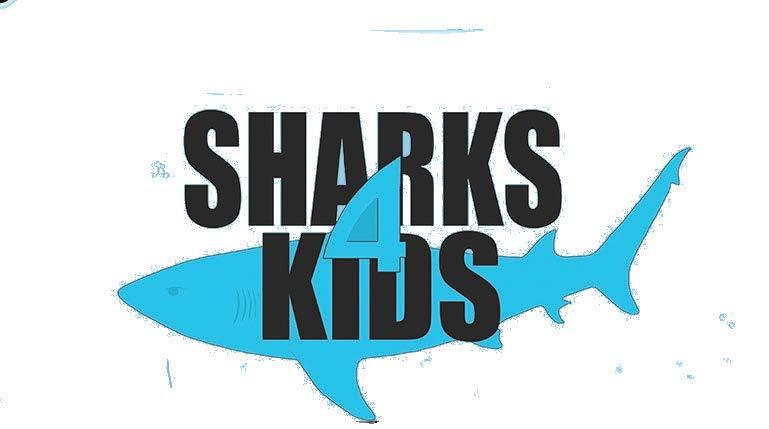
THROUGH EDUCATION, OUTREACH AND ADVENTURE
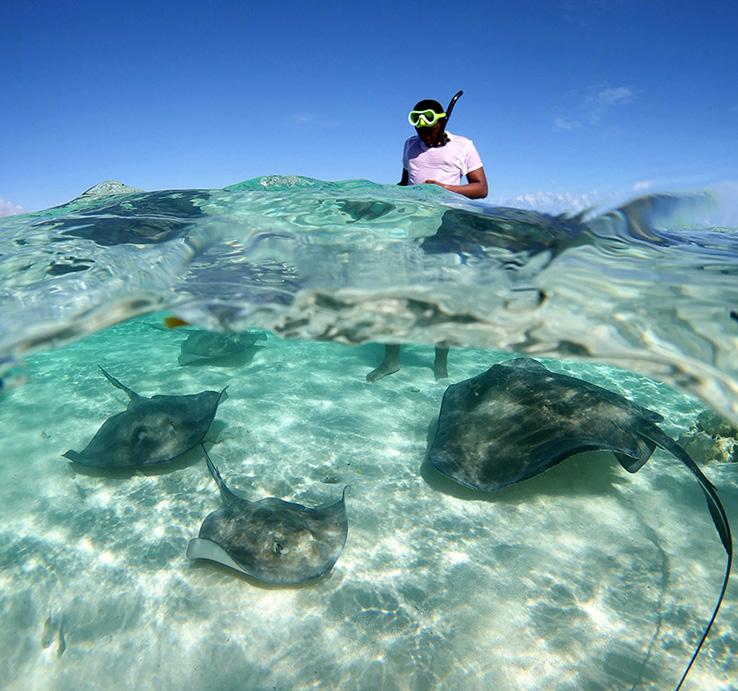
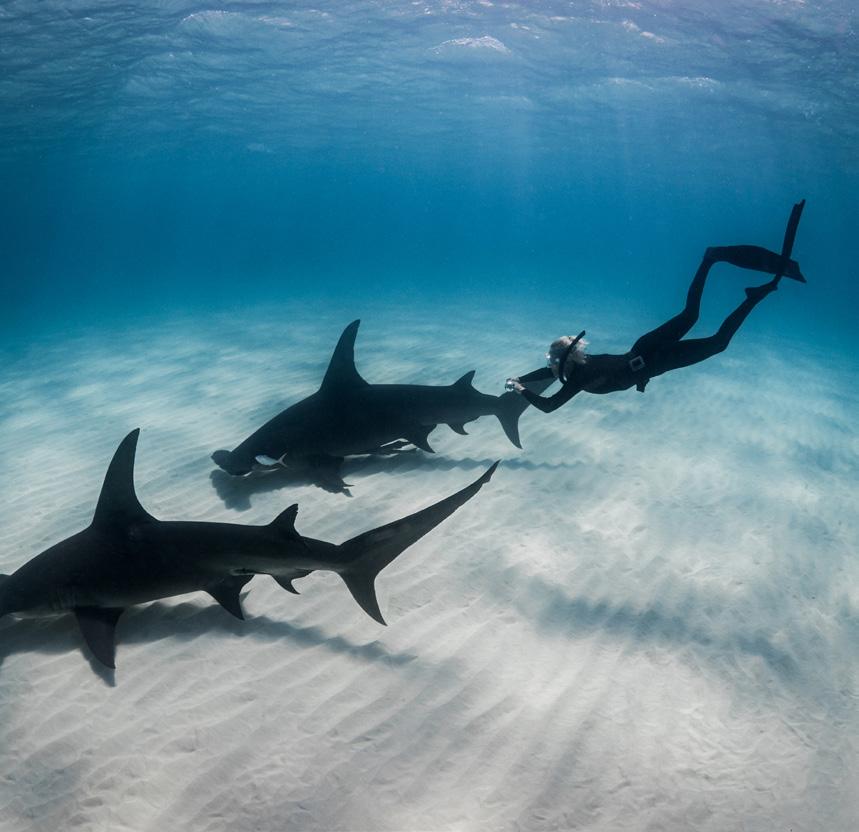

The goal of Sharks4Kids is to create the next generation of shark advocates through education, outreach and adventure. We provide a dynamic range of interactive learning materials and experiences for students of all ages. Our team of marine biologists and educators also provides virtual and in person lessons to bring learning to life in your classroom, library or home learning space. Dive into the world of sharks with us!
18 | SAVING EARTH FOR KIDS
www.sharks4kids.com
MUSICAL BREAK GET UP AND DANCE!

https://youtu.be/x5dDLruKdac
"Jim and Jerry Johnson liked to collect bugs Caterpillars beetles earthworms pill bugs slugs They’d pull their legs and clip their wings Until their mother told them to respect all things"
- from the album Ponderosa Bunchgrass and the Golden Rule

SAVING EARTH FOR KIDS | 19
By Jordan Cranmer
SAVING STURGEON IN THE NECHAKO WATERSHED
You can help protect Nechako White Sturgeon by keeping waste and litter out of the water and helping to protect their food sources, like Sockeye salmon!
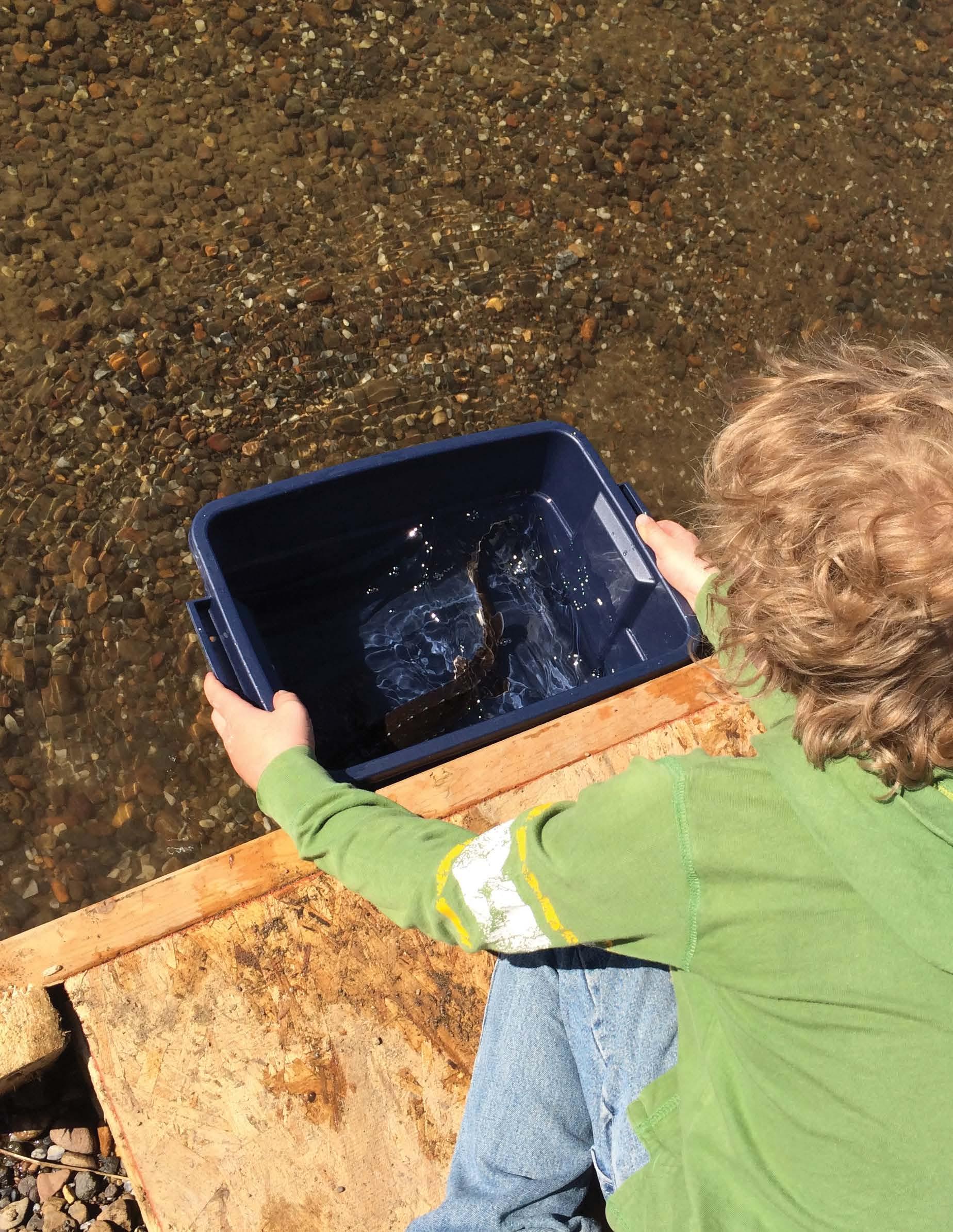
"Every year, elementary students from all around the Nechako River help release juvenile sturgeon from the conservation centre into the wild." Photos courtesy of Nechako White Sturgeon Recovery Initiative. nechakowhitesturgeon.org
“
Did You Know? Nechako White Sturgeon can grow to more than three meters long and over 300 pounds.
“

If you travel up the wide and winding Fraser River in British Columbia, you will eventually reach the Nechako River. The Nechako River is home to a unique population of fish called Nechako White Sturgeon. Nechako means “Big River” in the Dakelh language, so it is only fitting that the Nechako is home to one of the largest freshwater fish in North America. These fish have ancestors that used to roam the earth with the dinosaurs and even look like ancient creatures, with five lines of sharp, bony plates called scutes lining their bodies.
Nechako White Sturgeon can grow to more than three meters long and over 300 pounds but are smaller than the Fraser White Sturgeon. Nechako White Sturgeon are a population of White Sturgeon that are endangered, so researchers from British Columbia are working to help rebuild and conserve the population.
Juvenile sturgeon are at the most risk because they have the lowest survival rates. Because of riverbank erosion and human development, there is more silt and sand in the Nechako River than ever before. This means that when sturgeon spawn in the river, their sticky eggs can become suffocated and die. Juvenile sturgeon have predators like river otters and eagles to worry about, too. Because juvenile sturgeon have low survival rates in the wild and can take up to 40 years to mature, the population can’t grow at a fast enough rate. There are only about 630 adult sturgeon left in the Nechako watershed, so when juvenile sturgeon don’t survive, the population doesn’t grow.
The Nechako White Sturgeon Recovery Initiative (NWSRI) is an organization of people that have come together to help save and research the Nechako White Sturgeon. The Nechako White Sturgeon Conservation Centre
in Vanderhoof, BC, is part of this initiative and raises juvenile sturgeon to be released into the wild. This is done with the hopes of helping juvenile sturgeon live to be adults by giving them a head start in a safe environment. Juvenile sturgeon are released from the Nechako White Sturgeon Conservation Centre when they are two years old with special identification microchips called PIT tags. These tags make it easy for researchers to identify sturgeon raised in the conservation center by a special number given to each fish. These tags can also be collected from river otter scat to count the number of sturgeon that river otters eat.
Every year, elementary students from all around the Nechako River help release juvenile sturgeon from the conservation centre into the wild. Each student gives their sturgeon a name connected to a PIT tag number that can be searched on the NWSRI website. Students can then log on to the Nechako White Sturgeon Recovery Initiative website to see if their sturgeon was ever captured by researchers or eaten by a river otter.
Sturgeon are a living piece of history that will live longer than many humans. It is important to protect and learn to live harmoniously with them. You can help protect Nechako White Sturgeon by keeping waste and litter out of the water and helping to protect their food sources, like Sockeye salmon! Another way you can help save the sturgeon is by learning all about them and their importance to Indigenous Peoples. Learning and teaching others about Nechako White Sturgeon will help protect their population.
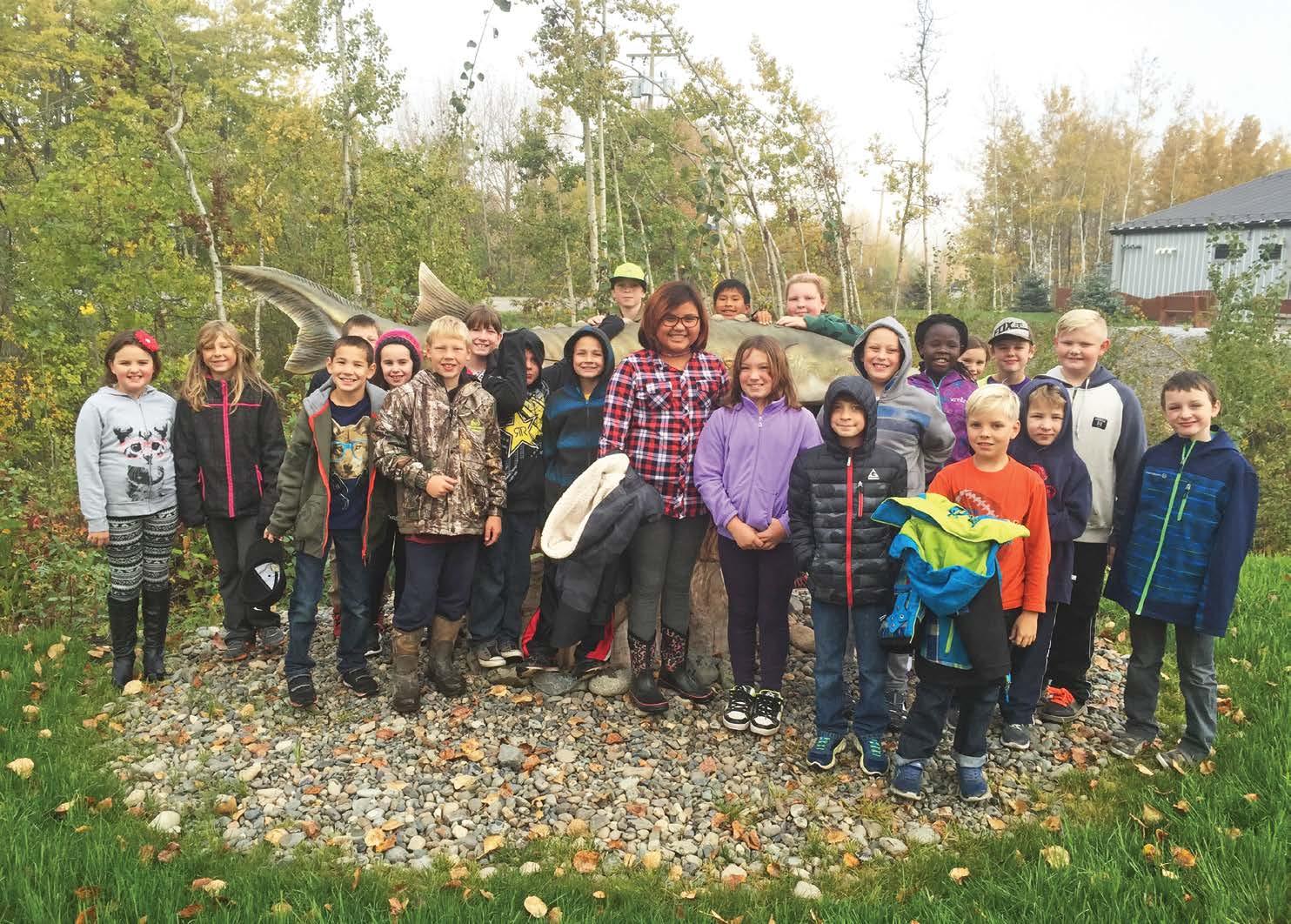
Visit nechakowhitesturgeon.org to find educational materials and watch our sturgeon YouTube videos! www.nechakowhitesturgeon.org
SAVING EARTH FOR KIDS | 21
Dan Meyers
CARING FOR CRITTERS
By Nicholas Read
 Excerpt from Caring for Critters: One Year at a Wildlife Rescue Centre by Nicholas Read (Heritage House, 2021). Reprinted with permission.
This photo was taken when Critter Care had 29 bears to look after. Everyone agreed it was far too many, but there was no alternative except to do their best. The sooner some of the bears are rehabilitated and released, the better. Photo credit: Critter Care Society.
Excerpt from Caring for Critters: One Year at a Wildlife Rescue Centre by Nicholas Read (Heritage House, 2021). Reprinted with permission.
This photo was taken when Critter Care had 29 bears to look after. Everyone agreed it was far too many, but there was no alternative except to do their best. The sooner some of the bears are rehabilitated and released, the better. Photo credit: Critter Care Society.
22 | SAVING EARTH FOR KIDS
In spring, when the Critter Care Wildlife Society, a wildlife rehabilitation centre in Langley, British Columbia (on unceded Kwantlen traditional territory), is brimming with orphaned pups, cubs, and kits, staff and volunteers often work 12 to 14 hours a day because they have to. But that’s what Critter Care is about. There are other wildlife rehab centres in BC, too, but Critter Care is the only one in southern BC to concentrate its care on raccoons, rabbits, squirrels, coyotes, bears, deer, opossums, beavers, porcupines, mink, and more.
By the fall, baby season should be well and truly over, yet Critter Care has received two more orphaned bear cubs. Their mother was shot, tragically, by conservation officers because they felt she was an irredeemable problem bear who was teaching her cubs to forage for food in alleyways and people’s backyards. But as Critter Care founder Gail Martin says, that, or a version of that, is what they always say. The only thing she knows for sure is that now, thanks to those COs, Critter Care has nine bears to look after instead of seven.
The BC Conservation Officer Service is an office of the government that, despite its name, is primarily a law enforcement agency. This is important in terms of protecting people from dangerous situations with cougars, bears, coyotes, wolves, and other animals, but also stopping people from breaking laws against hunting or fishing when and where they’re not supposed to, or otherwise harming animals and their habitats.
Officers are legally allowed to shoot and kill wildlife when they perceive it to be a danger to people. Unfortunately, there is a history of conservation officers acting too quickly with their guns and many animals are injured, killed, or orphaned as a result. Not only that, if a conservation officer should happen upon a distressed adult coyote, bear, or cougar, he or she must kill it rather than attempt to treat it.
Because of the difficult regulations from the government and the fact that so many animals are brought to Critter Care as a result of actions by conservation officers, there is understandably a lot of frustration and tension between the two organizations. It’s only been in recent years, and in reaction to a public outcry against the continued killing of animals (primarily bears), that the BC Conservation Officer Service now attempts to relocate them.


Later in the fall, Critter Care received a young bear they name Thumbelina, which should tell you everything you need to know about how big—or small—she is. Actually, at just under five kilograms (11 pounds), it would be fair to say she’s tiny. A lot of housecats weigh more. Thumbelina was probably born in January of that year,
These two bear cubs were brought to Critter Care in January almost frozen to death, and made a quick and complete recovery. They were called Frosty and Rocky.

separated from her mother soon after, and left alone. So, she didn’t grow, but she didn’t die either. She’s a black bear runt who’s getting a second chance at life, thanks to reliable helpings of rice, protein shake, strawberries, grapes, and regular (for now) doses of banana-flavoured antibiotics she needs for a mild infection. And yes, she will remain awake all winter. Not so for the society’s other nine bears, who now eat only every other day and sleep many more hours than they remain awake. When they are awake, it’s mainly to prepare their dens for their long winter’s nap.
After a couple of weeks, Thumbelina is off her antibiotics. Her infection has cleared so she’s eating normally and gaining weight. That means she’s also off the protein shake, which was never intended for bears. Instead, she’s adjusting to a diet more typical of bruins: fruits and vegetables. Bears are so big, strong, and potentially dangerous (those sharp claws and enormous teeth) that it surprises many people to learn they’re mainly vegetarian. That changes during the autumn salmon runs, when they can’t get enough of the big, oily fish. But in spring and summer, their diet consists mainly of plants. Yes, they’ll happily turn over a log and slurp up all the bugs underneath, and if they live by the sea, they’ll swallow clams and mussels with a gourmand’s gusto. They’ll even scarf down barnacles like popcorn. But they’re not the carnivores
that wolves and cougars are. Providing the helping is big enough, they’re perfectly happy with salad for dinner and berries for dessert.
In the third week of November, it happens again—another orphaned cub is rescued. Nathan, a volunteer, and Laura, who has graduated from intern to full-time employee, successfully captured him together with a couple of COs. Unfortunately, the operation was anything but picture perfect. But when the cub is safe, Laura can’t help but be heartened by the fact that she and Nathan got to work alongside the COs when they attended the bear. That rarely happens. But this time, they acted as partners, Laura says, and that was a promising development. She hopes it will happen again.
There are many gaps in how BC treats its wildlife and wild spaces, including allowing some outdated and harmful practices (though, in 2017, it did outlaw the hunting of grizzly bears). For over two decades, scientists and environment advocates have been calling for new or updated laws that would better protect endangered species, but progress has been frustratingly slow.
Learn more at heritagehouse.ca/book/caring-for-critters
Photo credit: Critter Care Society.
SAVING EARTH FOR KIDS | 23
Critter Care does everything it can to cure the sick and heal the injured, including engaging top-flight veterinary surgeons to work on particularly difficult cases. Here, Dr. Ken Macquisten works on a bear cub's paw. Photo credit: Critter Care Society.
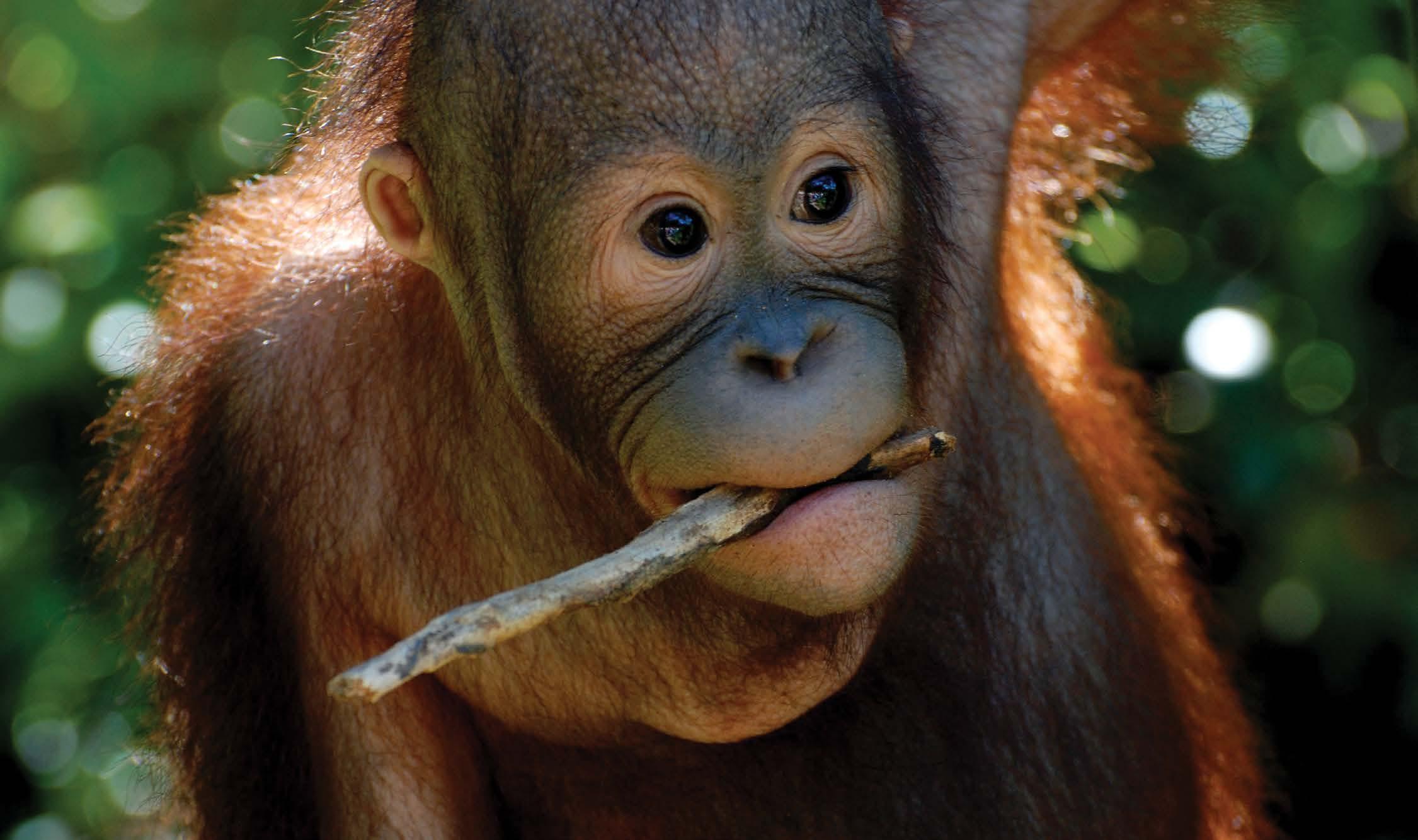
HOW TO SPOT AN ORANGUTAN
BY RUTH LINSKY
The name orangutan comes from two Malay words, orang, which means person, and hutan, which means forest, so orangutan means person of the forest.
Orangutans, who are known for their red-orange hair and long arms, are Great Apes. That means they don’t have tails, and they have hand-like feet and forward-facing eyes. The orangutan is the only Great Ape that inhabits Asia. They are found only in certain jungles on the islands of Borneo and Sumatra in the countries of Malaysia and Indonesia. Orangutans spend almost their entire lives in the trees. They eat there, sleep there, and travel by scrambling from branch to branch. They very rarely come down to the ground.
We know a lot about orangutans today in large part thanks to Dr. Biruté Mary Galdikas, a Canadian scientist who has spent 50 years in the jungle studying orangutans. She is recognized as a leading authority on orangutans because prior to her field study of orangutans, scientists knew very little about the apes in the wild.
One of the things Dr. Galdikas discovered about
orangutans is they spend a great deal of time foraging for food. This means they spend a long time, at least six hours a day, looking for food and eating food. They find all their food in the trees and build nests in trees near where they eat. They most like to eat ripe fruits. They also eat leaves, tree bark, nuts, and sometimes insects. Researchers have recorded over 1,400 different species of plants that orangutans eat across their range.
Orangutans have short, thick bodies with shaggy red or orange hair. They have long, powerful arms and short legs. Adult male orangutans can be twice the size of the females. The adult males can be almost 4.5 feet (1.4 meters) tall. They may weigh as much as 285 pounds (130 kilograms).
Orangutan babies live with their mothers longer than any other mammals except humans. They don’t leave their moms until they are between 10 and 12 years old. Orangutans can live to about 50 years old in the wild.
24 | SAVING EARTH FOR KIDS
Photo credit: Jeremy Stewardson.
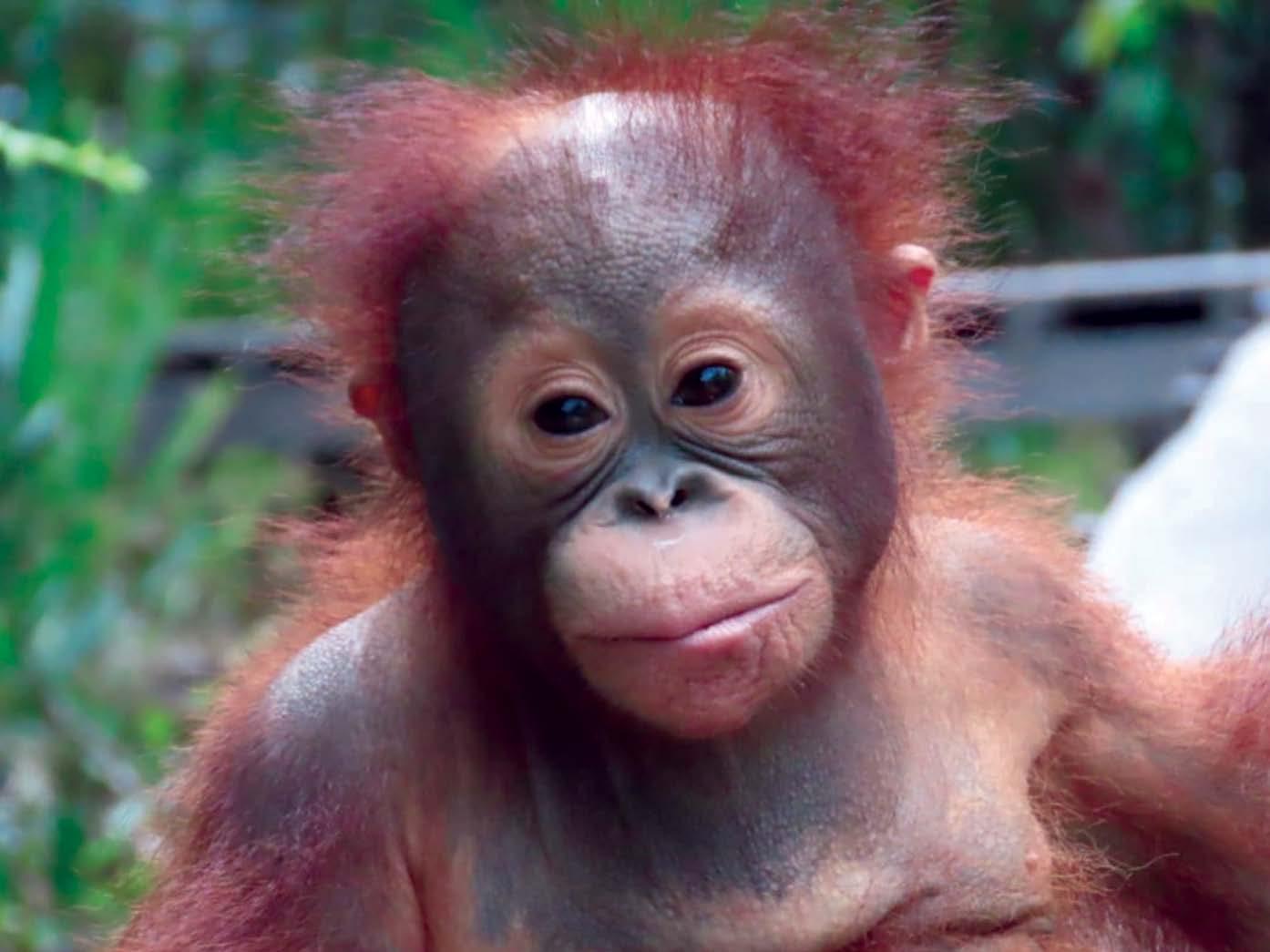
Like humans, orangutans use tools. For example, Dr. Galdikas noticed how Bornean orangutans use branches to test water depth or poke termite holes, and they use leaves as umbrellas, sponges, and napkins. Orangutans are a lot like us; in fact, they are one of humans’ closest relatives.
Why do orangutans matter?
Orangutans are like gardeners in the forest. They play a vital role in spreading seeds to help the forest grow and replenish. Orangutans also provide a window into our own human evolutionary history. By learning about orangutans, Dr. Galdikas has helped us learn more about our own species.
Unfortunately, orangutans face a risk of extinction because humans are cutting down rainforests to make paper and wood products and to make room for palm oil plantations, leaving the orangutans at risk of losing all of their natural habitat.
Dr. Galdikas founded a research camp in 1971 where she also rescued orangutans who needed care and protection until they could be safely released back into the wild. That camp is called Camp Leaky, and it is named after Dr. Louis Leaky who helped her get started in her research. To continue the rescue and rehabilitation work, a specific Orangutan Care Center and Quarantine (OCCQ) facility was built in a nearby village in 1998. The OCCQ is currently home to 285 displaced orangutans. Over the past 50 years, Dr. Galdikas and her Orangutan Foundation International organization have returned almost 1,000 injured or at-risk and orphaned ex-captive or ex-pet orangutans back to a life in the wild.
What can you do to help orangutans? You can continue to learn more about these fascinating and captivating apes by visiting Orangutan Foundation International, the foundation Dr. Galdikas set up to save orangutans (orangutancanada.ca).
Ruth Linsky is a PHD student in the Department of Biological Sciences at Simon Fraser University. She studies and supports the work to protect orangutans at Camp Leakey, Indonesia. She is also a founding board member of Orangutan Foundation International Canada, a sister charity to OFI based in Vancouver BC, Canada orangutancanada.ca

Reynolds
Canadian
is currently being cared for at OFI's Orangutan Care Center and Quarantine. As Dr. Galdikas has said, "When an orangutan looks at you, it's like they're looking straight through you into your very soul." Orphaned orangutans are cared for by caregivers who love and nurture them to give them the confidence and skills to one day return to the wild.
Right photo: Riga, her juvenile son Reijkavyk, and her infant son Rambutan still clinging to her side, hang in the trees near Camp Leakey. Orangutans have the longest inter-birth interval of any mammal (even humans!). Orangutan young stay with their mothers in the wild until they are 8-10 years of age. Sons may still follow their mother around when she has a new infant but eventually leave and may travel very far from where they grew up. Female orangutans often stay nearby the home range of their mother.
Photo credits: Orangutan Foundation International Canada.
Left photo: Orphaned orangutan Ryan
(named after the
actor)
SAVING EARTH FOR KIDS | 25
MOTHER
An Invitation into the World of Forest Communities through Scientific & Indigenous Lenses.
TREES
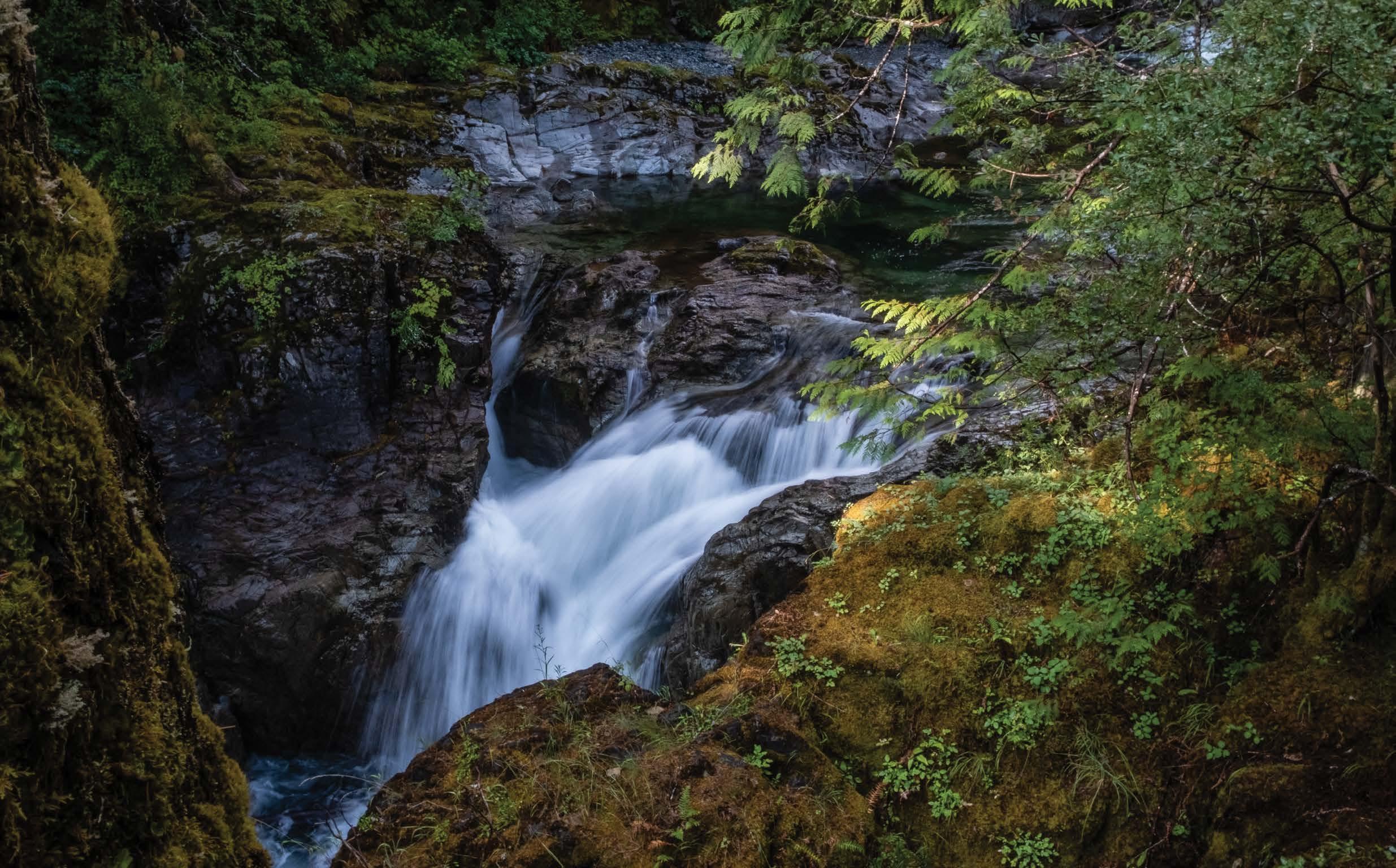 By Ascher & Cher, Sierra Club BC
By Ascher & Cher, Sierra Club BC
www.sierraclub.bc.ca/education
Mother trees are part of an interconnected system.
Forest beings are all interconnected. Through flows of energy and nutrients, all forest beings work together in a broader web. The energy flows happen above and below the ground. Tree beings in the forest have deeply complex root systems, which are connected through mycelial networks. Mycelium is a part of fungus that grows in a branching mass. It is the vegetative part of the fungus and consists of many hyphae. Mycelium connects tree roots between the same and different species of tree relatives and facilitates the sharing of nutrients and information between plants in the whole forest.
Some tree relatives have more of these interconnections than others. The ones with the most connections to other beings are called Mother or Grandparent trees. These beings are usually some of the oldest trees in the forest and therefore are connected to many other beings. They can be thought of as hubs for nutrient sharing between beings.
QUESTIONS FOR SELF-REFLECTION:
1. Take a walk in the forest. Where do YOU see connections happening?
2. What beings call the forest home?
3. How are people connected to the forest?
4. How are forest beings connected?
Hey, Teachers! Learn more about interconnected systems through A Pathway Together, a gift bridging Indigenous and diverse lenses around climate action.
https://prezi.com/view/HwO7tPJC1Cs7Be4nWjdq/

“Like
the Mother Tree, we have so much that is below the surface that might not be visible to everyone.”
- Cultural Voice kQwa’st’not (Charlene George)
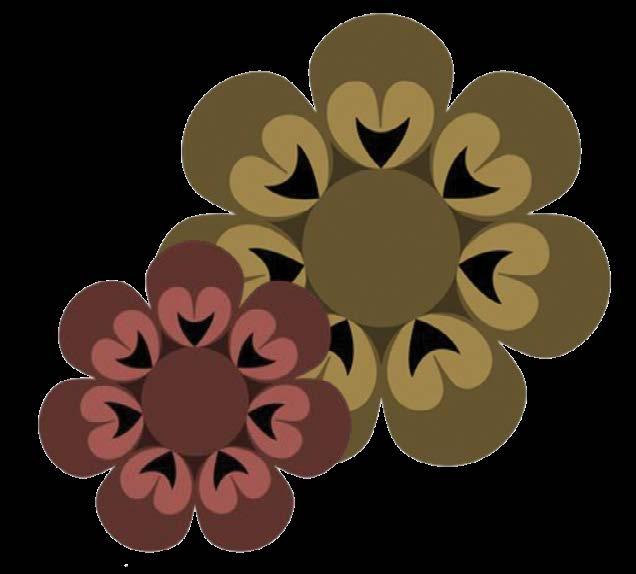
26 | SAVING EARTH FOR KIDS
Photo credit: Mya Van Woudenberg. Art work by C. George.
LOCAL INTACT FORESTS
We encourage you to go for a walk in your local forest community and take part in the pdf activity (link below) on ancient trees!
https://sierraclub.bc.ca/wp-content/uploads/Ancient-Trees-of-BCMay-2020.pdf
WHO STILL LIVES IN THESE INTACT FOREST COMMUNITIES?
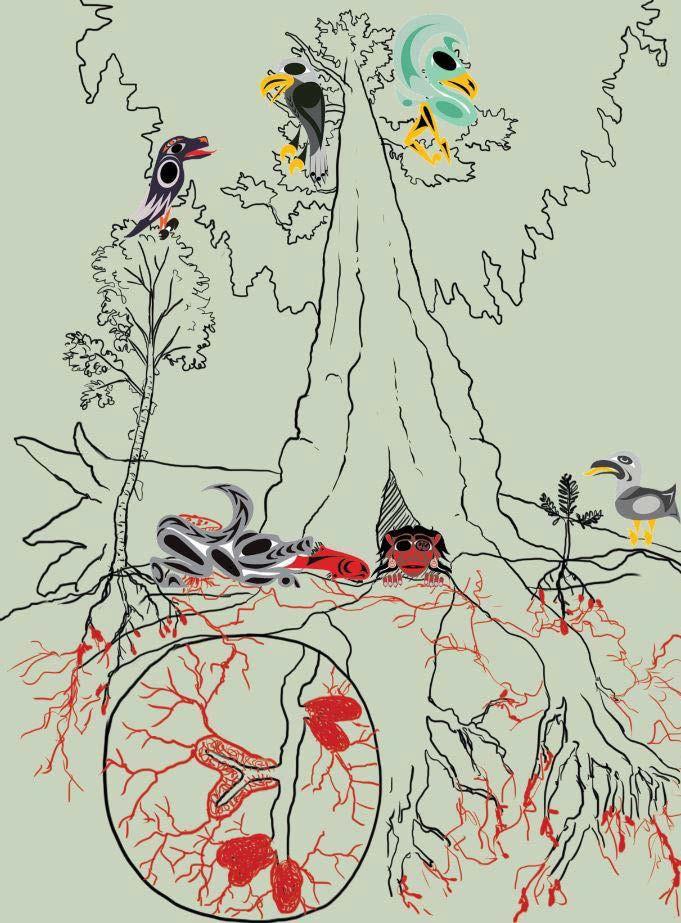
We are all connected. All beings have relations with one another and are interconnected. We invite you to continue building your relationship with the beings from the ocean to the sky. Drawing them in the places they call home will support you in making a connection to all of them. We encourage you to take time to explore your creativity and how they are interconnected.
GO TO the Sierra Club BC webpage where you will find webinars to help you learn more.
https://sierraclub.bc.ca/safe-communities-ng/
Learn to draw webinars: Learn to draw the mother tree with Dr. Julius Csotonyi and Dr. Suzanne Simard. https://sierraclub.bc.ca/learn-to-draw-mother-tree-withsuzanne-simard/
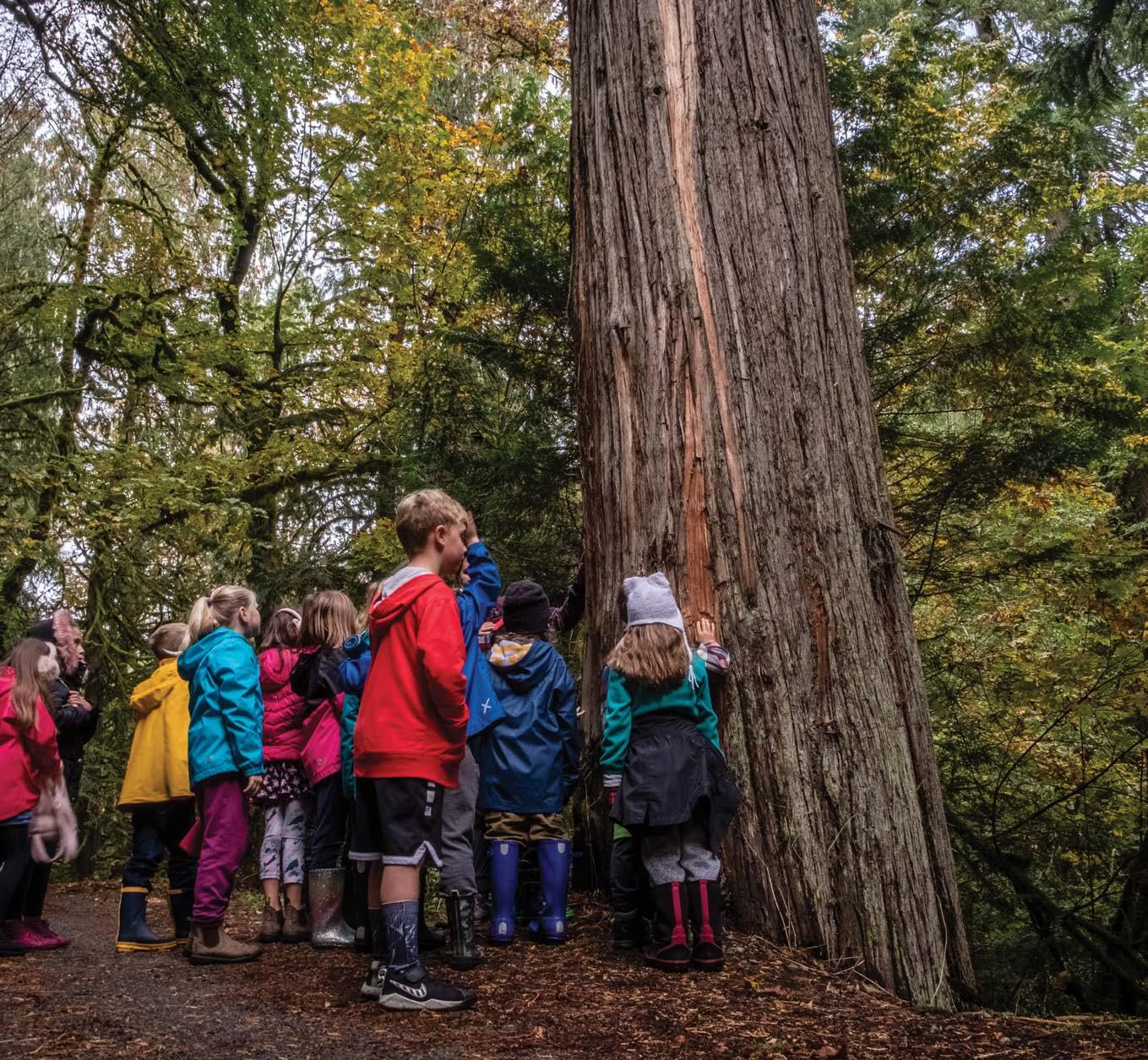
SALMON ARE WHAT FEEDS THE WHOLE FOREST COMMUNITY
Pacific salmon species are key in many ecosystems and support many other beings.
Different species of Pacific salmon vary in terms of their life cycles. Some spend hardly any time in natal streams (the stream where they were born); some spend years. Some mature at two years of age; some mature at five. Some live for only a couple of years; oth-
ers live for ten. And some, like Steelhead and Cutthroat, can even spawn more than once.
Read and Learn more by downloading the pdf The Salmon Life Cycle
https://sierraclub.bc.ca/wp-content/uploads/ Salmon-Lifecycle-Package-April-2020-1.pdf
BIG QUESTIONS
1. Did you know that nurse trees are the ones that have fallen to the ground and create homes for many forest beings? Who lives in these high nutrient nurseries sometimes called ‘decaying trees’?
2. Can protecting screech owls help Mother Trees? Do you know that owls and bats live in communities centered around Mother Trees?

SAVING EARTH FOR KIDS | 27
? ? ? ? ? ? ? ?
Photo credit: Vidar Nordli-Mathisen
COLOUR ME
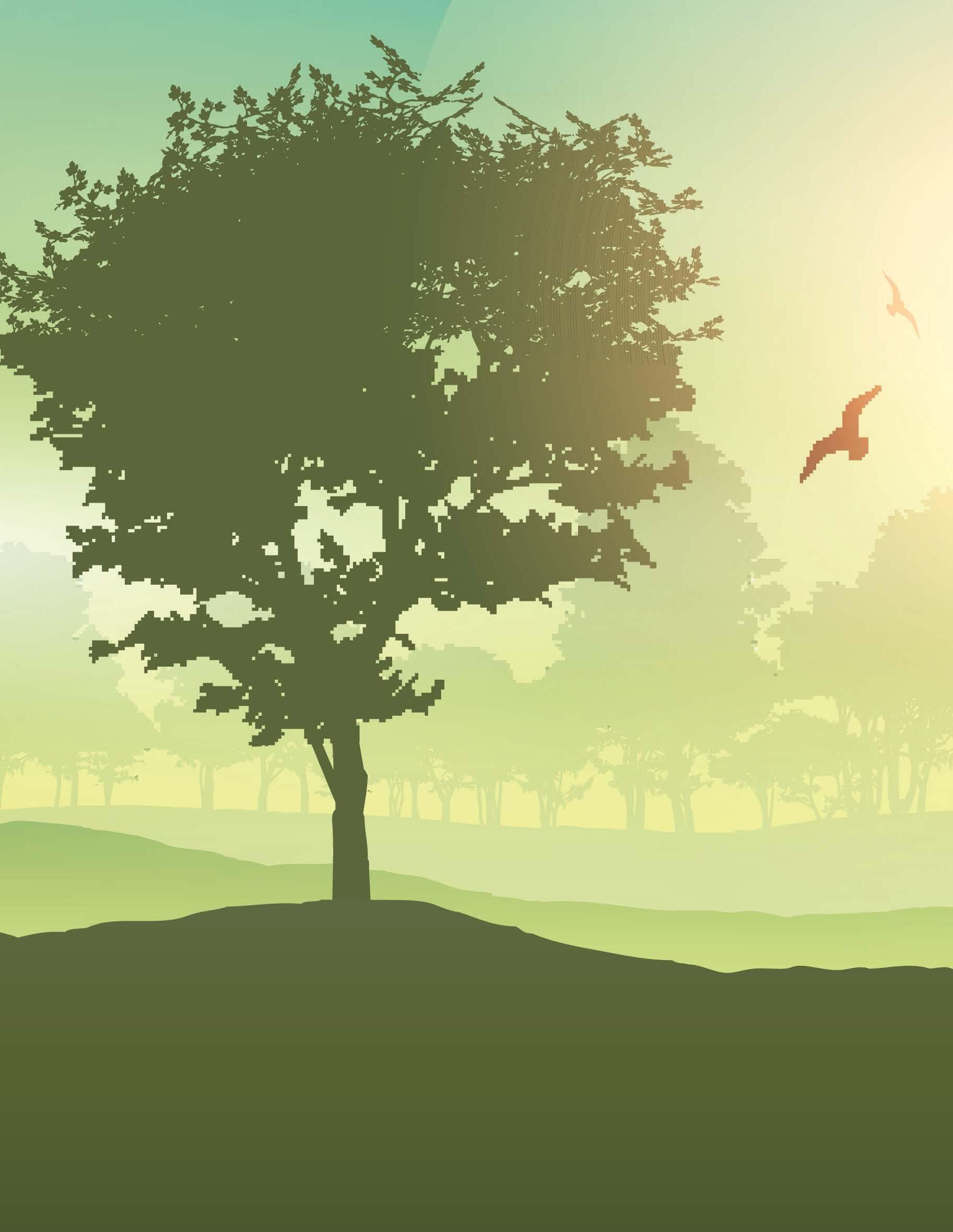
28 | SAVING EARTH FOR KIDS
By Angela Legh
IN THE FOREST A WALK A
lone, you step onto the path. The trail turns through the tree-studded landscape; you cannot see far ahead. Sunlight filters through the leaves, creating a dappled shade on the ground. The air is warm. A slight breeze adds gentle movement to the trees. Oak, elm, beech, and birch trees are growing wildly in this forest. Underneath the trees are bushes scrambling for space—some are reaching upward in an attempt to access light, others sprawl across the ground, creating a lush environment. You know you can explore this area safely, so you forge ahead.
You first notice the sounds—the birds twittering, tweeting, and calling in the trees, the soft wind rustling the leaves, and the muted shuffling of your feet on the path. Then you notice how quiet it is—no cars or people chattering. You smile and take a moment to absorb the forest atmosphere. It feels safe here; even your mind quiets from the hustle and bustle of daily life.
You notice the scent of the land. You smell the soil beneath your feet, but it is mixed with the smell of damp moss, the decaying leaves that clutter the path, and the fresh, clean scent of the air. It is a pleasant combination that brings you a sense of peace. You sense there is magic in this space, and your imagination takes wings as you conjure up fairies, rainbows, and unicorns in your mind’s eye.
The path takes an uphill turn, and now rocks are mixed into the dirt. You must keep your eyes on the ground to keep from tripping over the uneven stones that poke through the soil. Even still, your eyes are pulled upward to take in the landscape’s beauty. You trudge upward, eager to see what unfolds on this journey.
Occasionally, you meet other hikers, and you smile at them as you step aside into the undergrowth to let them pass. As the trail climbs, you see an opening in the tree line. When you reach the top of the hill, you step into a meadow covered with yellow flowers, stretching as far as your eyes can see. You notice that someone has added a rope swing to the tree on the edge of the meadow and, seeing an opportunity for fun, you slip onto the swing and let yourself soar.
Giggles bubble up in you as you sail into the sky. When the swing hits its apex, you can see beyond the meadow’s edge to the forest on the other side. The swing falls backward, then up again, and you see your feet pointing upward toward the clouds. You wonder what it would feel like to fly like a bird, to have

the freedom to move wherever you want through the sky. You realize that swinging is the closest thing you can do to feel that freedom in this present moment.
When done swinging, you take a moment to sit under the oak tree that holds the swing. Leaning back against the trunk, you thank the tree for the shade it provides, for doing its work turning carbon dioxide into oxygen, and for providing a space for play. Looking up, you see clouds floating above, sunlight gleaming on the leaves, and the gentle way the leaves dance in the breeze.
After a while, you continue on the trail, skirting the edge of the tree line. You feel the sun’s warmth on your shoulders and the slight breeze on your back. Before getting too hot, the trail dips back into the forest as you move into the shade and away from the lovely meadow. You see your town below through a gap in the trees. You look for your house, locating nearby landmarks. You feel grateful to be seeing your neighbourhood from a different perspective.
The trail descends toward the parking area. As you walk under the trees, you feel grateful for the opportunity to journey through this beautiful space. Your eyes have feasted on the ever-changing scenery; your ears have basked in the silence and the sounds of nature. Your sense of smell bathed you in the delightful scents of woods and earth. You touched the tree bark and felt the roughness. In this short, one-hour walk, you feel rejuvenated and at peace.
Thank you for journeying me on this virtual walk through a forest. The setting is real, based on walks I used to take in the Cotswold area of England. There is a fantastic group of people who place rope swings in random places, and you have a decent chance of encountering a swing on your hikes.
While all forests are different, walking in any one of them can evoke feelings of peace, calm, and well-being. The Nature Conservancy reports that spending time in nature, whether in a forest or a city park, correlates with a drop in anxiety and depression.
In Japan, there is a practice called Forest Bathing, in which an individual or a group, enters the forest and spends three to five days immersed in nature. This practice has been found to reduce stress, reduce your heart rate, increase immunity, improve sleep, and spark creativity.
Research reveals the benefits of spending even short amounts of time in a forest or tree-lined park include improved mental and physical health. In fact, even having an image of a forest in your environment can provide health benefits!
By Saving Earth Green Team
MICROPLASTICS LITTLE PIECES,

BIG PROBLEM
Plastic is a material that humans created over 100 years ago and now it’s all around us. It’s in the toys we play with, electronics in our homes, and items we buy when shopping or at the grocery store.
30 | SAVING EARTH FOR KIDS
When exposed to light, plastics break down into small pieces through a process known as 'photodegradation.' These small bits of plastic, known as microplastics, make up the majority of items found in the Pacific Garbage Patch, where they float suspended in the water column.
Photo credit: NOAA Marine Debris Program.
Though plastic has helped make things lighter, safer, and more flexible, it is contributing to a lot of waste on our planet. Unlike natural materials, such as wood or paper, plastic breaks down very slowly because it is a really strong material that is built to last. It can take over 400 years for plastic to break down completely! This means that once we throw it away, it can be sitting in a landfill for a really long time or end up as pollution that harms wildlife and our environment. One way this happens is through super small pieces of plastic called microplastics
What are microplastics?
Microplastics are teeny tiny plastics that are 5 millimeters in length or smaller, which is about the size of a grain of rice.
Microplastics are making their way into our soil, waterways, and even food systems every single day, yet most of them are smaller than what we can see with the human eye. Though tiny, these plastics are having a large impact on the world around us.
Where do microplastics come from?
Microplastics can be made on purpose, or they can be caused by larger pieces of plastic breaking into smaller pieces over time. Knowing the source helps determine where the waste came from and can be used for creating reduction targets.
• Primary Microplastics - Primary microplastics are those created for a special purpose, meaning they were designed to be small. Glitter and sparkles are examples of primary microplastics.
• Secondary Microplastics - Secondary microplastics are those created from bigger pieces of plastic wearing down and breaking off, almost like crumbs. An example of secondary microplastics is when you find tiny pieces of the plastic on the beach from the ocean.
These microplastics tend to start their journey through water systems like sinks, pipes, drains, and even your washing machine at home. These tiny plastics are so small they can easily slip through drains and filters that are used to help clean water before it’s disposed of. So, there can be hundreds and thousands of microplastics secretly flowing through the pipes in our homes at any given time, without us even realizing.
Another “secret” offender for microplastics is synthetic fabrics that are human-made and not found in nature. These are commonly used for home goods and clothing. When you wash your clothes and the washing machine drains its water, these microplastics travel with it into our water treatment systems. At first, this may not seem like very much, but if you think about how often you do laundry, and how many people do laundry every day, it really adds up!
What impact are microplastics having on our planet?
known at this time. Researchers, scientists, and engineers are working to better understand the effects that microplastics have on our planet, wildlife, and humans.
What can I do to help combat microplastics?
You can help protect the environment by reducing microplastics in your own life! Give these tips a try:
1. Put Your Waste in its Place. Make sure you’re putting waste where it belongs. Check if it can be reused, composted, or recycled before throwing it in the garbage. This will help keep things from going to the landfill, and it will reduce waste.
2. No Littering. Avoid littering to help keep nature clean and beautiful.
3. Talk to Your Friends and Family. A great way to make a difference is by starting a conversation with your friends and family about microplastics and how you can work together to reduce them. Share what you have learned and ask questions about microplastics and alternative products along the way.
By reducing your individual contribution to microplastics, you’ll help reduce the amount entering our waterways, affecting our environment, and impacting wildlife. By treading a little lighter on our planet, we can all do our part to help create a more sustainable future for generations to come.
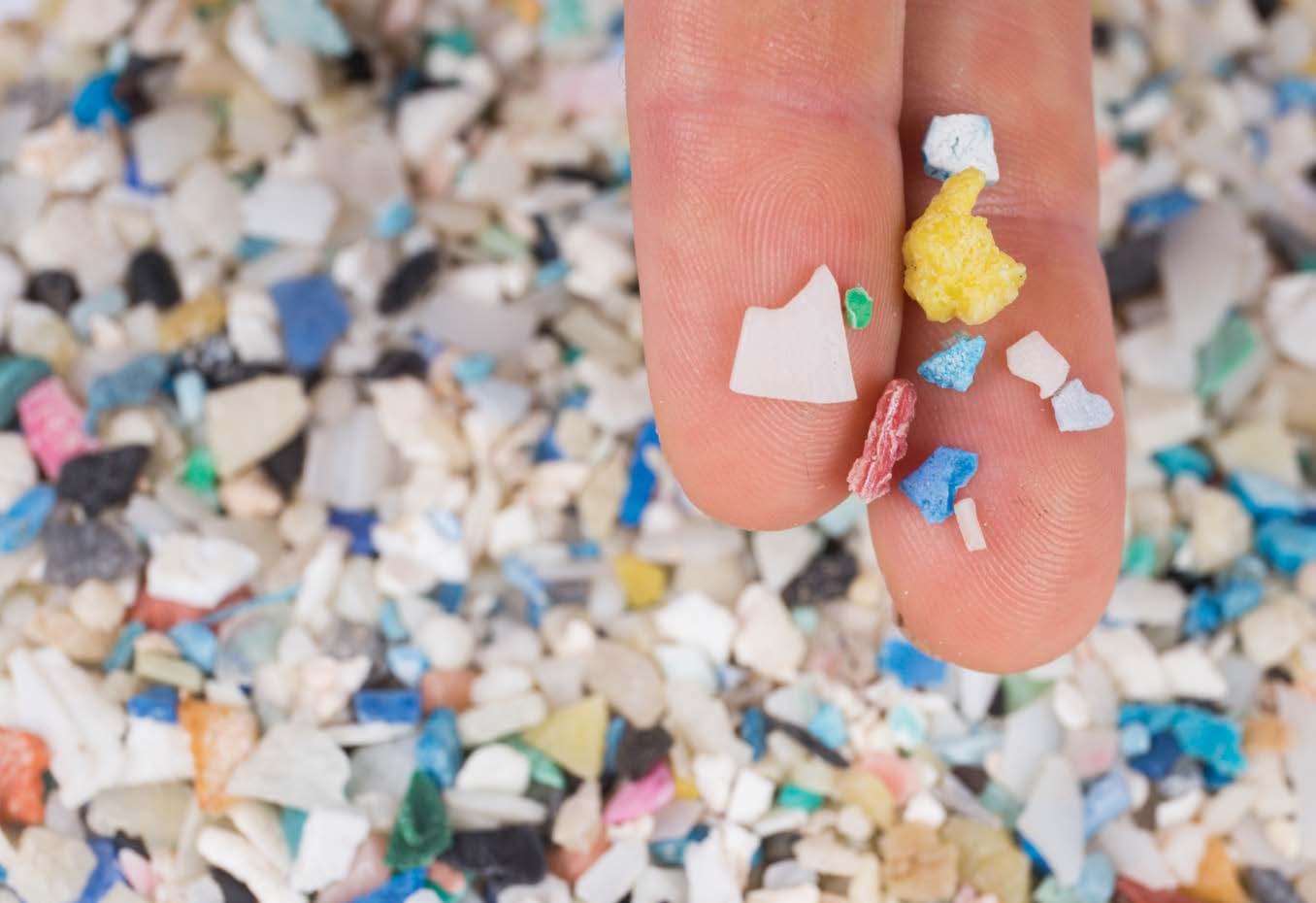
Researchers have found that microplastics can travel from homes and industrial processes to waterways, oceans, the Great Lakes, and other environments. We also know that their small size means they can and are being ingested by a wide range of creatures, from marine plankton, fish, and turtles to other ocean life and even humans. It isn’t healthy for wildlife or humans to ingest plastic of any kind, as it can lead to becoming sick, having problems with eating, or even dying.
In addition to microplastics being present in natural ecosystems and our food chain, microplastics have also been found in the air we breathe because of the planet’s weather trends. These plastics are all around us, but their full impact is not clearly
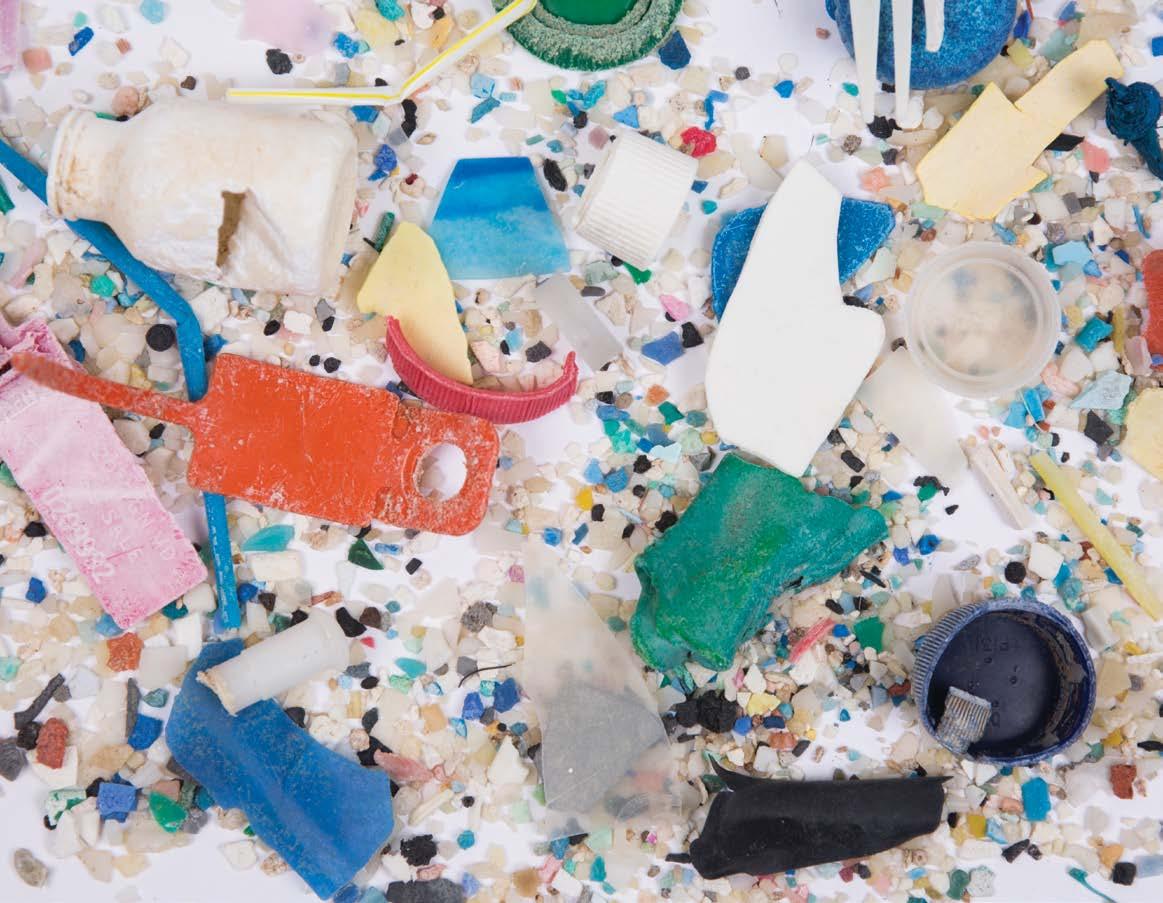
SAVING EARTH FOR KIDS | 31
Microplastics
from a freshwater stream. Photo credit: Florida Sea Grant.

32 | SAVING EARTH FOR KIDS
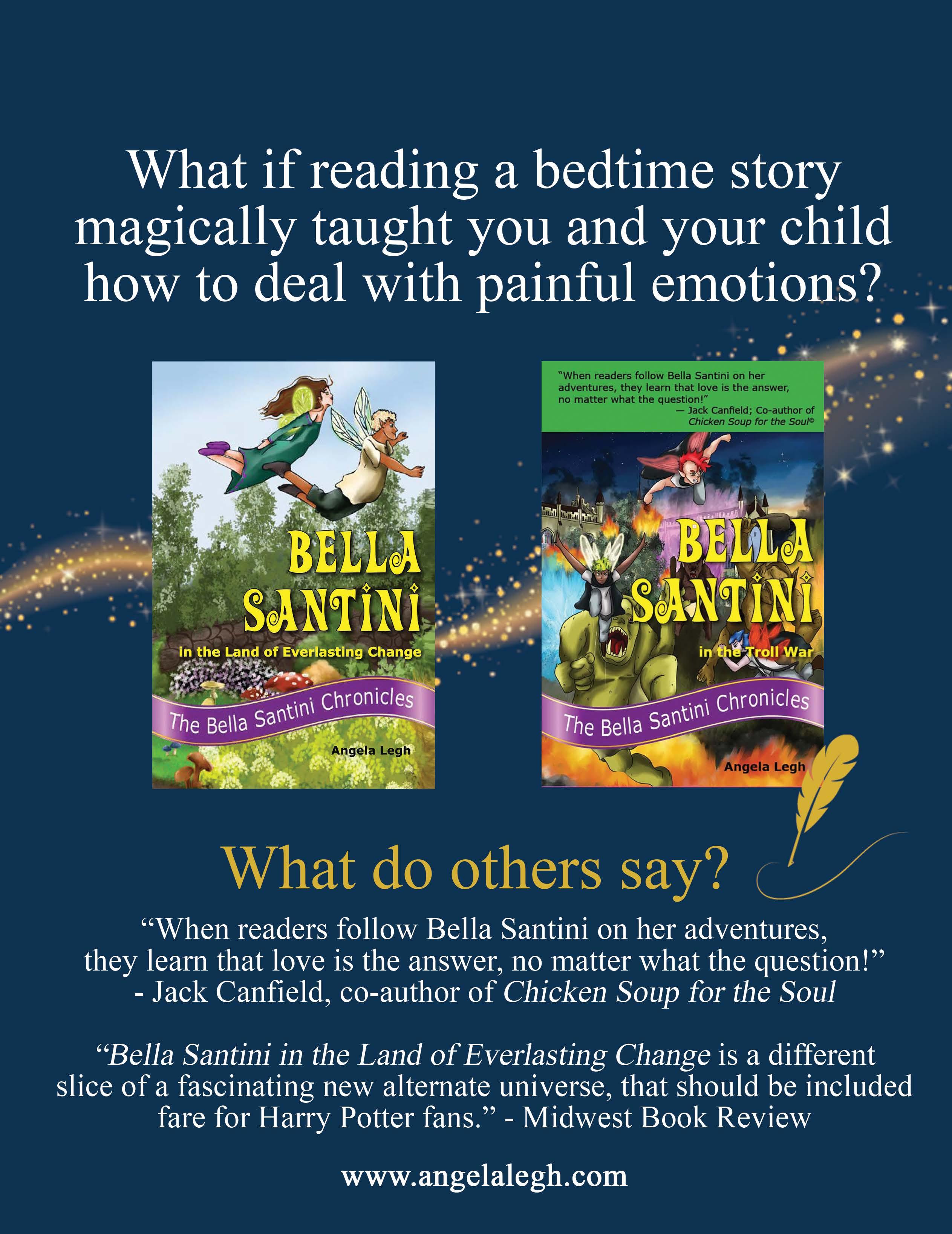
Thomas #LocalHero Submitted by Mind Your Plastic mindyourplastic.ca/10-questions-with-mays-localhero-thomas
10 QUESTIONS WITH LOCAL HERO, THOMAS
Thomas, a six-year-old boy from Ontario, has decided to make an impact in his community with his passion for the health of our oceans by selling Krispy Kreme Donuts to raise money for ocean conservation. With a goal of selling 1,002 donuts, Thomas blew past that number with a record 1,080 donuts sold! He hopes to donate the profits of the fundraiser to organizations like Plastic Oceans Canada.
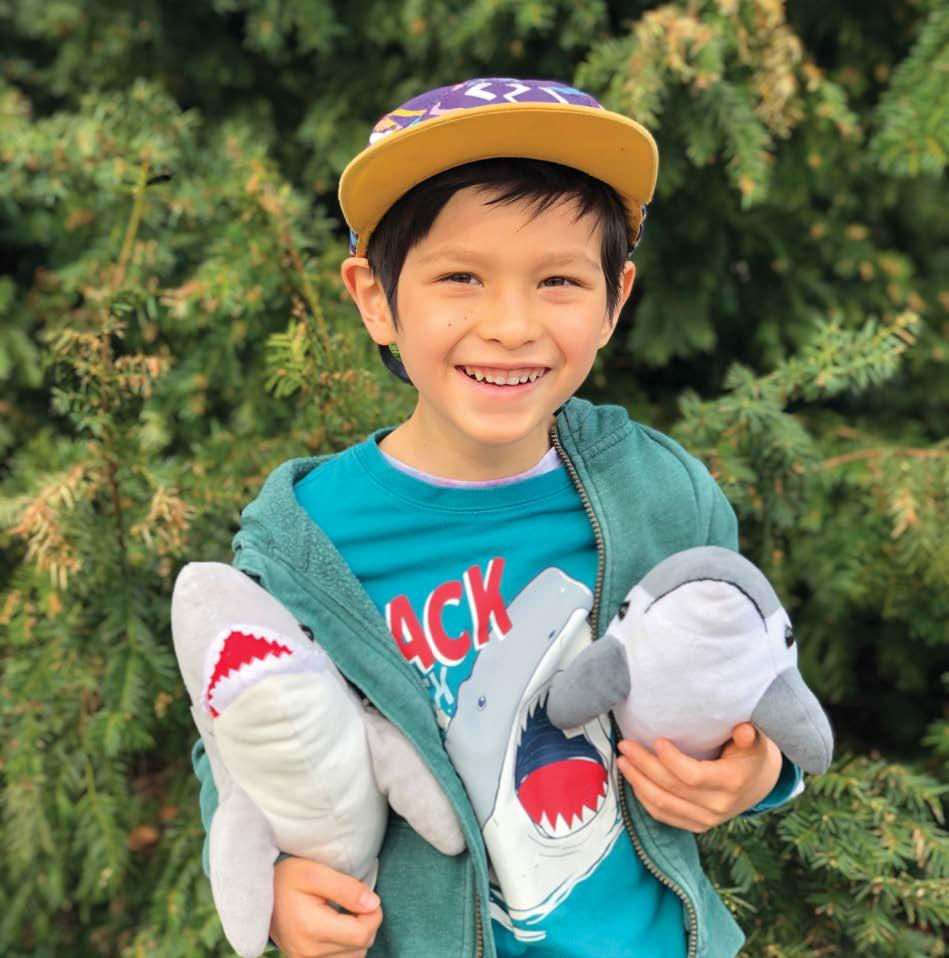
We caught up with Thomas to find out what makes him so interested in helping oceans, what motivates him, and how other people can help the environment!
Tell us a bit about yourself.
Hi! My name is Thomas. I like lots of different things. I like Pokemon, weekends, skateboarding, climbing trees, parkour, and swimming! I live in Toronto with mommy and daddy and my little brother.
What motivated you to start selling donuts for our oceans?
When I learned that too many people were putting plastic in the ocean I wanted to help. We can’t clean the ocean ourselves because we live in Ontario, and even if I was at the ocean my parents would only let me go in shallow water and I can’t clean up the ocean by myself. I wanted to sell donuts because they are yummy, and no one would come if I sold broccoli or tomatoes or carrots.
Can you tell us why having a clean ocean is so important?
Because the ocean gives us a lot of resources and it cleans our air. I also like the animals in the ocean, and I want them to be safe.
What actions do you take to help the environment? Why are they so important?
When I leave my room, I turn off the lights because I try not to waste electricity. After I wash my hands, I turn off the tap because I don’t want to waste water. I try to not waste my food because animals died for me, and the farmers did a lot of work for it. It’s important because it helps the environment because the resources won’t be there forever, and we need to learn how to save it properly.
What challenges or obstacles do you face when pursuing your goals?
My goal is to sell 1,002 donuts but that is a lot of donuts. I don’t know 1,002 people. And some people might not want to buy them because they might be allergic to sugar.
34 | SAVING EARTH FOR KIDS
Thomas, his artwork, and letter. Courtesy of Mind Your Plastic.

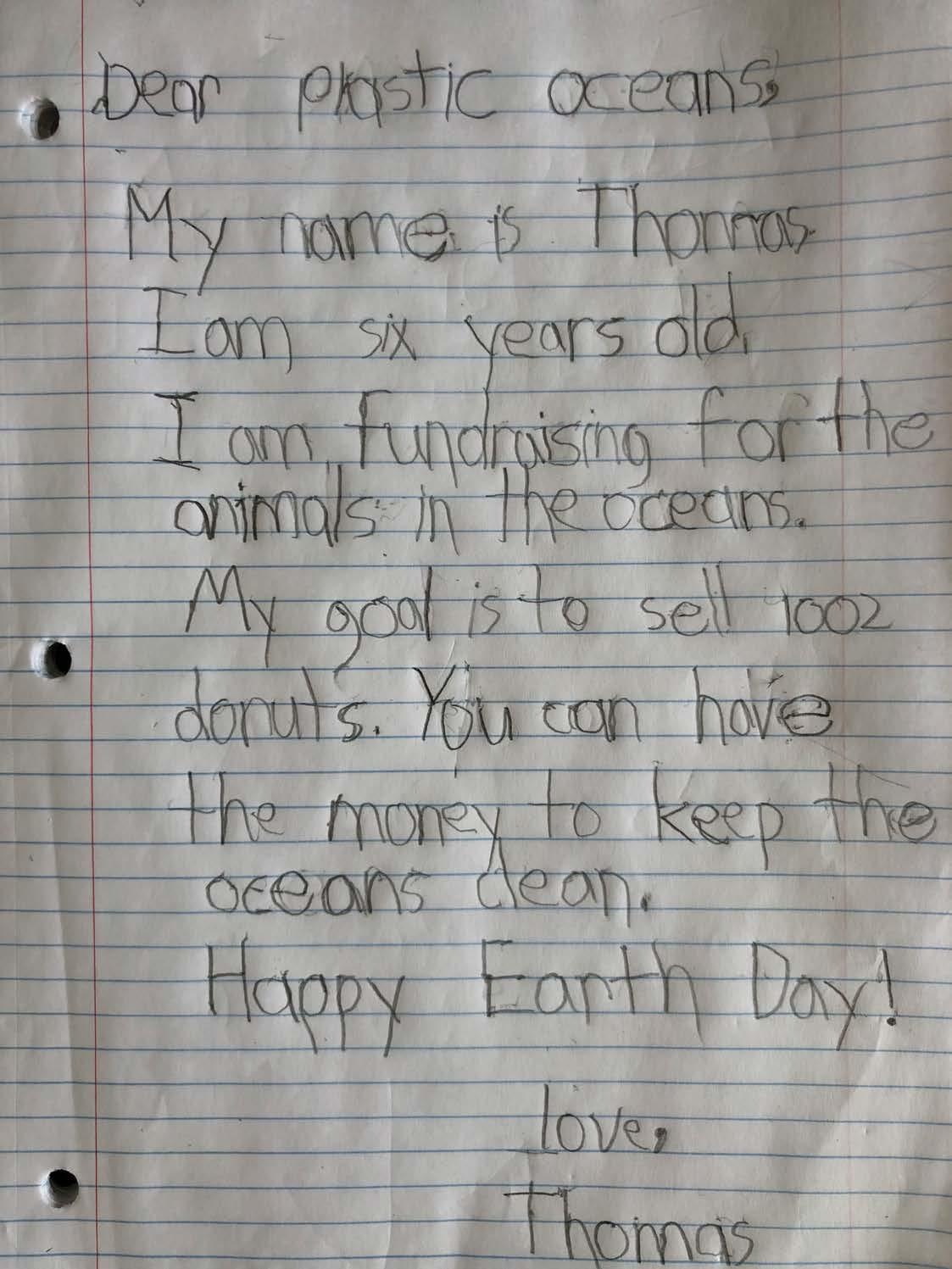
How do you keep yourself motivated?
I think about the little fishies and dolphins. And it is motivating when I get to count all my donut orders!
Who inspires you to be active in making a difference? Mark Rober inspired me to help the ocean. I saw him on Youtube. Wild Kratz also helped me learn about nature and want to help it. At school, I learned from my teacher about energy and the environment.
What has been your favourite experience doing this so far?
I’ve enjoyed figuring out how many donuts I have sold because it’s fun doing math. And I liked drawing my Keep the Oceans Clean poster.
What was something that surprised you while trying to maintain your goal?
It is surprising how much money I have raised already. It is surprising that sometimes people buy donuts but don’t want to eat them. And some people are donating extra money!
Do you have any recommendations for people wanting to make a difference in their communities?
Try and think of something that you like and is important to you and try to raise money for that. Ask your parents to help you fundraise because it’s hard to do it yourself. The more people that can help the more you can raise! You just need to try your best!
THANK YOU, THOMAS, FOR SHARING YOUR PROGRESS AND JOURNEY!
SAVING EARTH FOR KIDS | 35
WHY CANADA MUST DO MORE
TO TACKLE PLASTIC POLLUTION
By Sarah King, Greenpeace

When we look around our homes, we may not realize just how much plastic is part of our daily lives. From food packaging and markers, to clothes, furniture, and even stuffies, plastic is hard to avoid. But so much stuff made of plastic creates a big problem for the planet. Plastic in many forms is not only leaking into all corners of nature, causing a worldwide plastic pollution crisis, it is also making its way into human blood (and poop!). It’s time to ditch problematic, polluting plastic, and countries like Canada need to get to work.
Earlier this year, the Canadian government announced that six types of single-use, or throwaway, plastic will no longer be made or sold across the country. Plastic cutlery (forks, knives, chopsticks, spoons), take-out containers, sixpack rings, checkout bags, straws, and stir sticks that meet certain criteria will be banned starting next year. These are items that we all see in restaurants, stores, schools, and, unfortunately,
increasingly in the environment, particularly on shorelines and in our communities. But the list of problematic plastics that are causing problems in our waste management systems, leaking into our streets, and making their way into ecosystems is much longer.
Plastic beverage cups, bottles, cigarette filters, wrappers, Styrofoam, other types of bags, balloons and balloon sticks, certain types of toys, wet wipes, and more are regularly found in the environment and are often the top items picked up by shoreline cleanup organizations. Even the Canadian government’s own scientific assessment determined that some of the items listed above are problematic but has chosen to not ban them.
So, while it may sound like banning six types of plastic is a great move, the reality is that it only makes up about 3% of the plastic trash Canada generates each year. That’s a lot of plastic waste left to deal with.
36 | SAVING EARTH FOR KIDS
A crab was trapped inside a discarded Zagu milktea cup in Verde Island Passage, the epicenter of global marine biodiversity, in Batangas City, the Philippines. Photo credit: Noel Guevara / Greenpeace
What about recycling more plastic?
In Canada, less than 9% of plastic waste is recycled each year. Most of the plastic we use eventually ends up in landfills or is burned, and then thousands of tonnes end up as pollution that’s the weight of approximately 250 adult blue whales, the largest animal on earth! Even if all the plastic waste was recyclable and collected for recycling, our waste management systems aren’t able to process it all because we just make too much of it. And unlike some other materials, the quality of plastic gets worse over time, meaning it cannot be recycled over and over again into similar products. So much of the plastic we use even recycled plastic eventually just becomes waste.

Can we do more to clean it up?
The problem with plastic is that once it enters the oceans or most natural environments, it is virtually impossible to properly clean up. Plastic breaks apart into smaller and smaller pieces over time and spreads. If plastic ends up in the ocean, much of it ends up on the seafloor or becomes microscopic pieces, so small that even marine animals easily ingest it. We can pick up plastic in our communities but so much is leaking into our oceans and environment around the world that we can never collect it all. That’s why we must stop creating so much in the first place and especially stop creating the types of plastic that we don’t need, like packaging and other things we use for just a short time.
What about paper instead of plastic?
Ultimately, we don’t only want to reduce plastic waste we want to reduce all waste. There are many environmental problems that are threatening life on our planet. Deforestation and harmful farming are two big contributors to the climate and biodiversity crises we are facing. Simply replacing throwaway plastic packaging and items with disposable paper or other material alternatives may contribute to these crises. Even packaging or items like straws that say they are compostable still create pollution in the short term if they end up in the environment because many are only intended to break down in industrial composting settings. There is no such place as “away” when we say we’re throwing something away, so whatever we choose as alternatives to plastic must be a safe choice to keep using over and over again.
Turn the page for more on plastic. SAVING EARTH FOR KIDS | 37

Why we need reusable and refillable solutions
Reusable and refillable packaging and items are designed to be used over and over again, eliminating the need to throw stuff away. Lots of examples already exist around us, from reusable water bottles and coffee cups to entire grocery stores that keep products like shampoo and ingredients like flour in bulk containers for customers to refill on their own. And often products don’t even need to be packaged, presenting the opportunity for easy refill or use without unnecessary waste.
Drinks bottled in plastic could instead be refilled from a refrigerated machine or come in reusable bottles that are made to last. Restaurants could offer takeout in reusable containers shared by numerous restaurants in a town or city. Everything from crackers to cereal and granola bars could be offered in bulk or reusable, returnable containers in grocery stores, instead of packaging that contains plastic and paper.
The opportunities to reduce and eliminate throwaway plastic are enormous, but to make them happen we need the Canadian government to prioritize the creation and expansion of reuse and refill systems in our community. If we all show our support for reuse and overall plastic reduction, it can help major makers and sellers of plastic and governments to act faster to solve the plastic problem. The time to start is now!
 On World Clean-up Day, Greenpeace, alongside community allies, volunteers, and a Greenpeace local group, coordinate a clean-up activity and plastic polluter brand audit in Montréal. The audit seeks to identify the major corporate contributors to plastic waste polluting shorelines, green spaces, and communities. Photo credits: Greenpeace.
On World Clean-up Day, Greenpeace, alongside community allies, volunteers, and a Greenpeace local group, coordinate a clean-up activity and plastic polluter brand audit in Montréal. The audit seeks to identify the major corporate contributors to plastic waste polluting shorelines, green spaces, and communities. Photo credits: Greenpeace.

SAVING EARTH FOR KIDS | 39

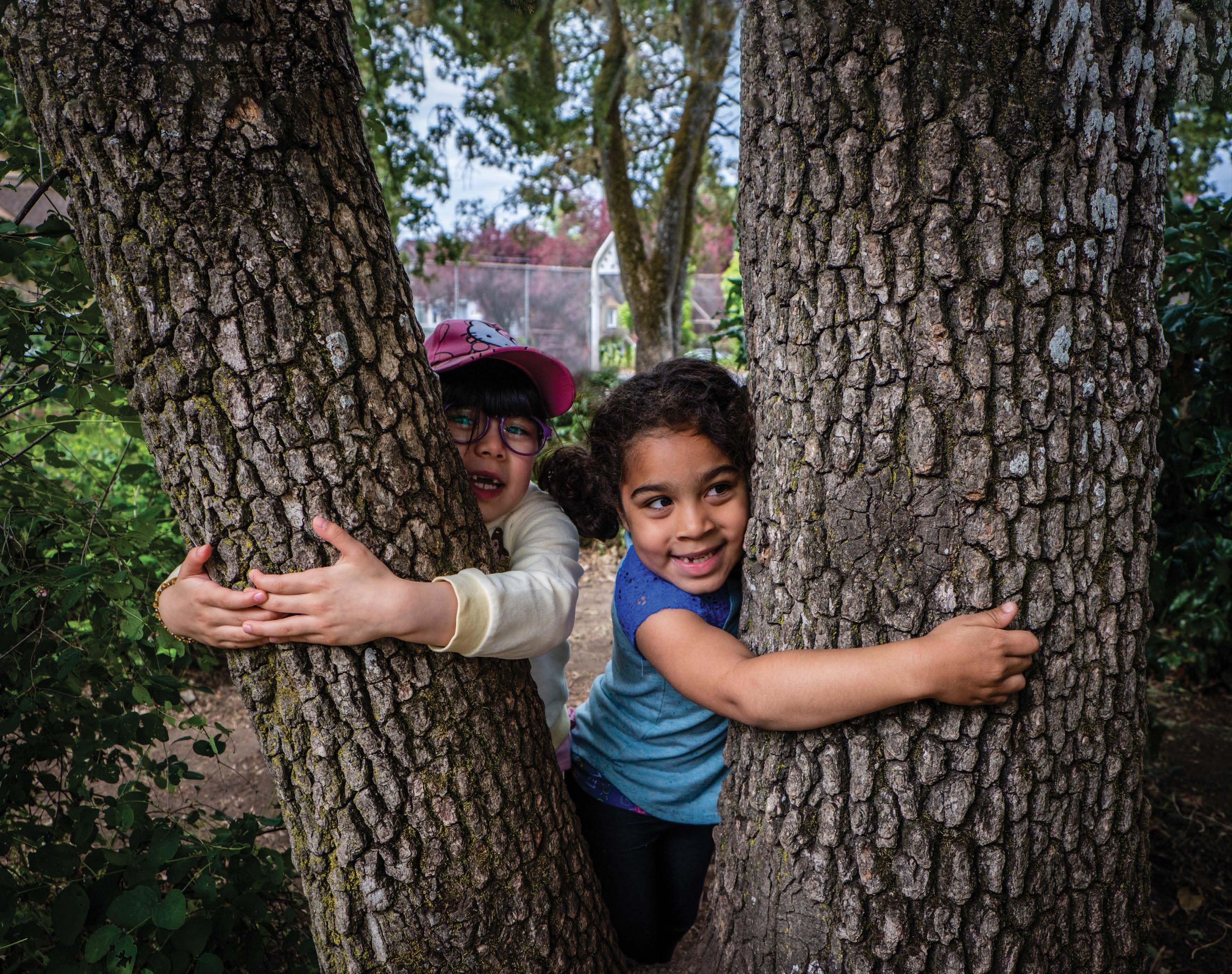

CONNECT WITH YOUR COMMUNITY! Have environmental education resources, special events, local Indigenous connections, community programs and more sent right to your inbox! Sign up for Sierra Club BC's education newsletter here: www.sierraclub.bc.ca/community




















































































































































































 Excerpt from Caring for Critters: One Year at a Wildlife Rescue Centre by Nicholas Read (Heritage House, 2021). Reprinted with permission.
This photo was taken when Critter Care had 29 bears to look after. Everyone agreed it was far too many, but there was no alternative except to do their best. The sooner some of the bears are rehabilitated and released, the better. Photo credit: Critter Care Society.
Excerpt from Caring for Critters: One Year at a Wildlife Rescue Centre by Nicholas Read (Heritage House, 2021). Reprinted with permission.
This photo was taken when Critter Care had 29 bears to look after. Everyone agreed it was far too many, but there was no alternative except to do their best. The sooner some of the bears are rehabilitated and released, the better. Photo credit: Critter Care Society.






 By Ascher & Cher, Sierra Club BC
By Ascher & Cher, Sierra Club BC


















 On World Clean-up Day, Greenpeace, alongside community allies, volunteers, and a Greenpeace local group, coordinate a clean-up activity and plastic polluter brand audit in Montréal. The audit seeks to identify the major corporate contributors to plastic waste polluting shorelines, green spaces, and communities. Photo credits: Greenpeace.
On World Clean-up Day, Greenpeace, alongside community allies, volunteers, and a Greenpeace local group, coordinate a clean-up activity and plastic polluter brand audit in Montréal. The audit seeks to identify the major corporate contributors to plastic waste polluting shorelines, green spaces, and communities. Photo credits: Greenpeace.



